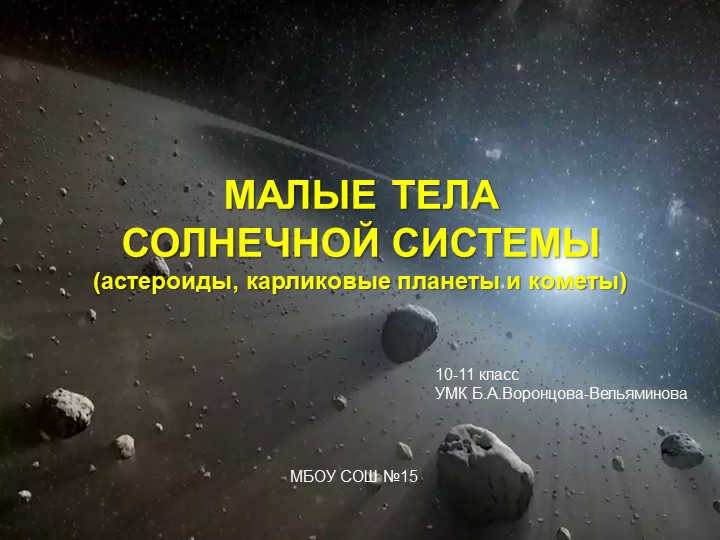
Currently, 58,742 educational institutions have the opportunity to take advantage of a range of additional discounts (ranging from 2% to 25%). To determine the specific discount available to all staff members within your educational institution, please access your personal Infoworks account.


Advanced Training Program
Techniques and Instruments of Business Technologies in Education
We have the ability to include your educational institution’s discount along with this offer (it is dependent upon the number of your peers who have enrolled in Infowork courses).
Currently, there are additional discounts (ranging from 2% to 25%) available for 58,742 educational institutions. To determine which discount applies to all staff members of your educational institution, please sign in to your personal Infoworks account.


Course for professional growth
Arrangement of activities for a teacher specializing in working with children who have intellectual disabilities
We can apply a discount from your educational institution to the current discount (the amount depends on the number of your colleagues who have completed Infoworks courses)
At present, 58,742 educational institutions are eligible for additional discounts (ranging from 2% to 25%). To determine the discount applicable to all employees of your educational institution, please log in to your personal Infoworks account.


Urban Ecology: City as an Ecosystem
Explanation of the presentation through individual slides:

1 slide SMALL BODIES
SOLAR SYSTEM
(asteroids, dwarf planets, and comets)
MBOU SOSH NO. 15
10-11 grade
B.A.Vorontsov-Vel’yaminoff’s teaching materials
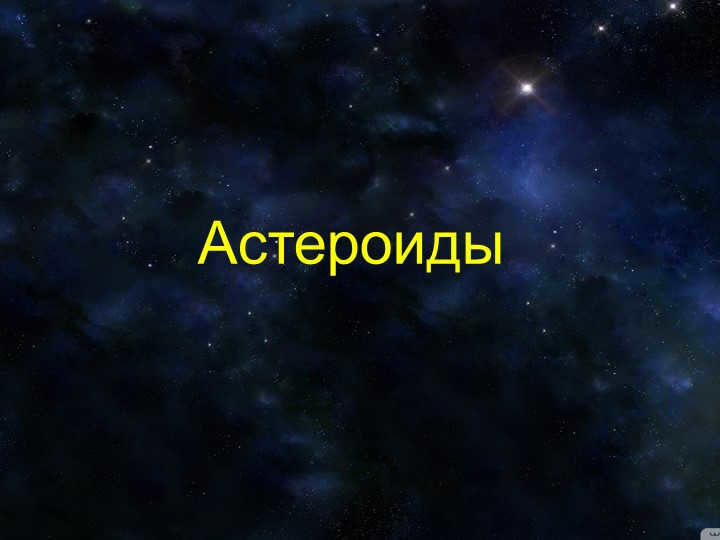
slide 3 Ceres
Telescopic observations reveal small planets or asteroids (star-like)
as brilliant points resembling stars.
In the year 1801, a diligent search in the region between Mars and Jupiter led to the discovery of a diminutive planet, which was subsequently named Ceres, drawing inspiration from ancient mythology (approximately 1000 km in diameter).
Subsequently, two more celestial bodies, namely Pallada (550 km) and Vesta (530 km), were identified.
Vesta
Pallada
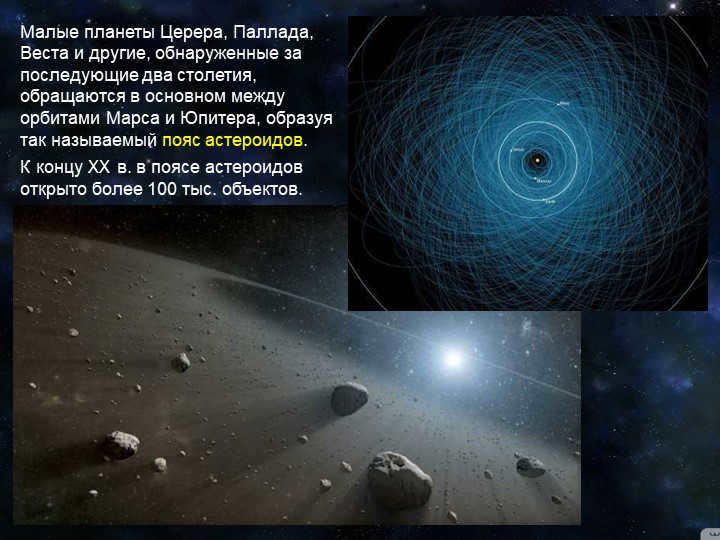
On the fourth slide, you will learn about the minor planets Ceres, Pallada, Vesta, and others. These planets were discovered over the course of the next two centuries and are known for orbiting between Mars and Jupiter. This area is commonly referred to as the asteroid belt.
In fact, by the end of the 20th century, scientists had discovered over 100,000 objects within the asteroid belt. It’s incredible to think about the vast number of celestial bodies that exist within our solar system.
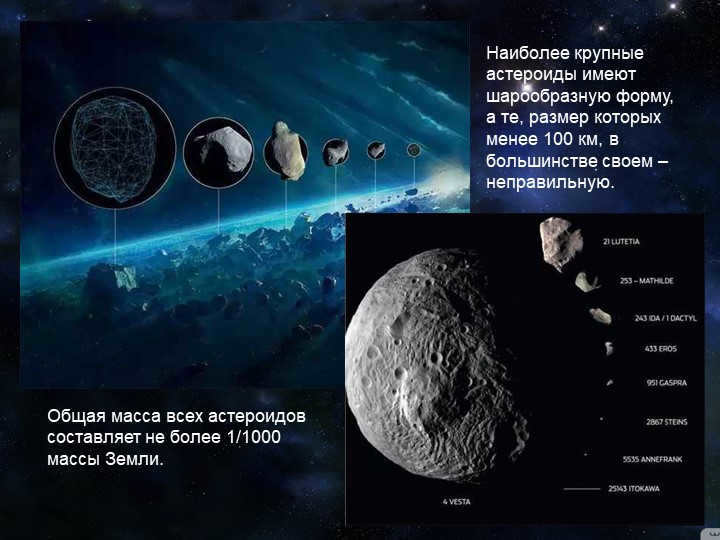

The majority of asteroids have a spherical shape, while the smaller ones, measuring less than 100 km, tend to be irregular in shape.
The combined mass of all asteroids is less than 1/1000 of the Earth’s mass.
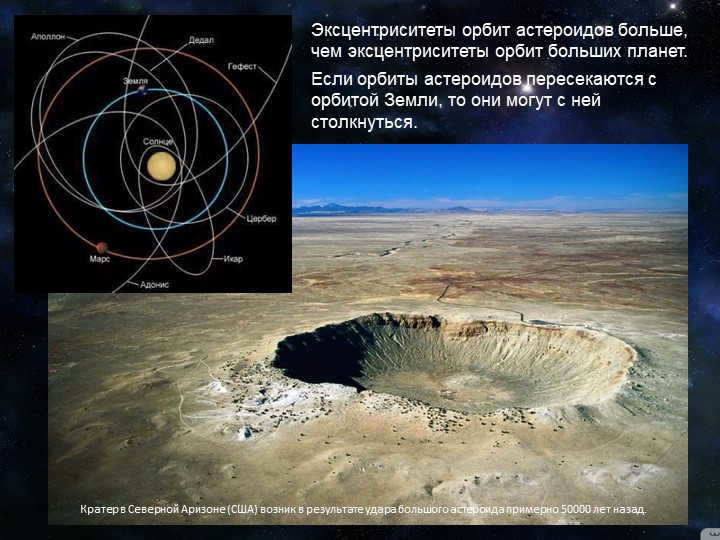
Slide 6: The eccentricities of the orbits of asteroids surpass those of the orbits of the bigger planets.
If the paths of asteroids intersect with the Earth’s trajectory, there is a possibility of collision.
The crater found in Northern Arizona (USA) was formed due to the impact of a massive asteroid approximately 50,000 years ago.
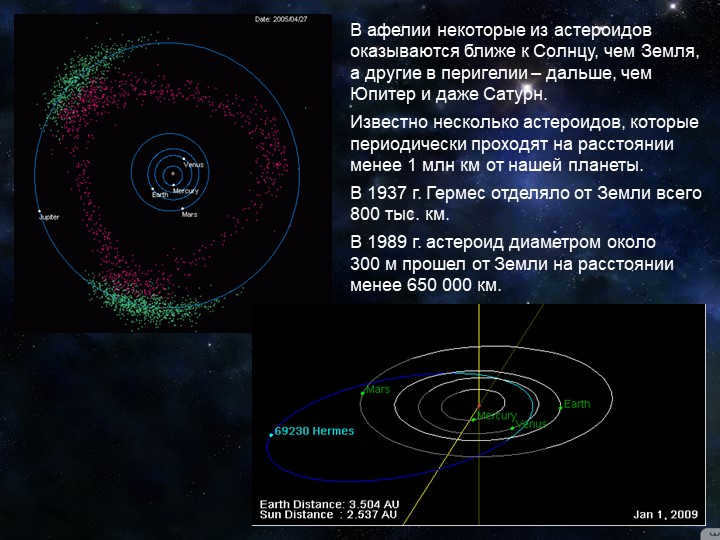
During aphelion, certain asteroids are located nearer to the Sun than the Earth, whereas others at perihelion are even farther away than Jupiter and Saturn.
There are several known asteroids that periodically pass within a distance of less than 1 million kilometers from our planet.
In 1937, Hermes came as close as 800 thousand kilometers from Earth.
In 1989, an asteroid with a diameter of approximately 300 meters passed by Earth at a distance of less than 650,000 km.
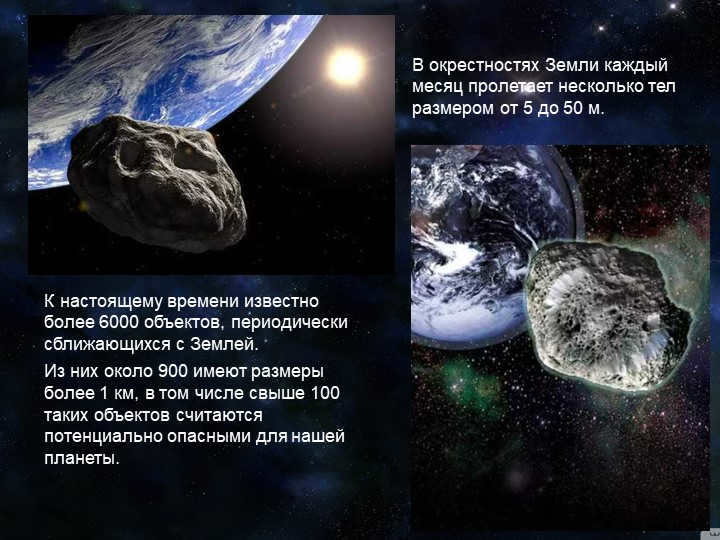

On a monthly basis, multiple objects measuring between 5 and 50 meters in size traverse near the Earth.
At present, there are over 6000 known objects that periodically approach the Earth.
Out of these, around 900 have dimensions exceeding 1 km, with over 100 of these objects being considered potentially hazardous to our planet.
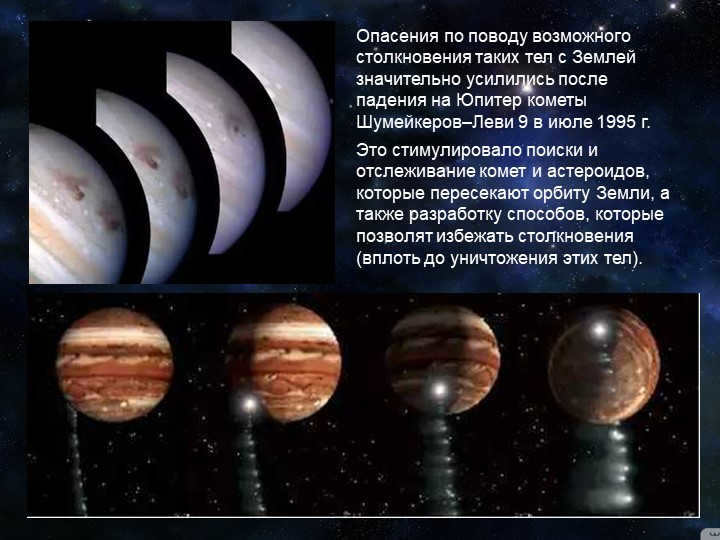

The concerns about the potential collision of these objects with Earth have significantly increased since the impact of Shoemaker-Levy 9 on Jupiter in July 1995.
This event has prompted an increased effort to search for and track comets and asteroids that intersect Earth’s orbit, as well as the development of strategies to prevent collisions (including the possibility of destroying these objects).
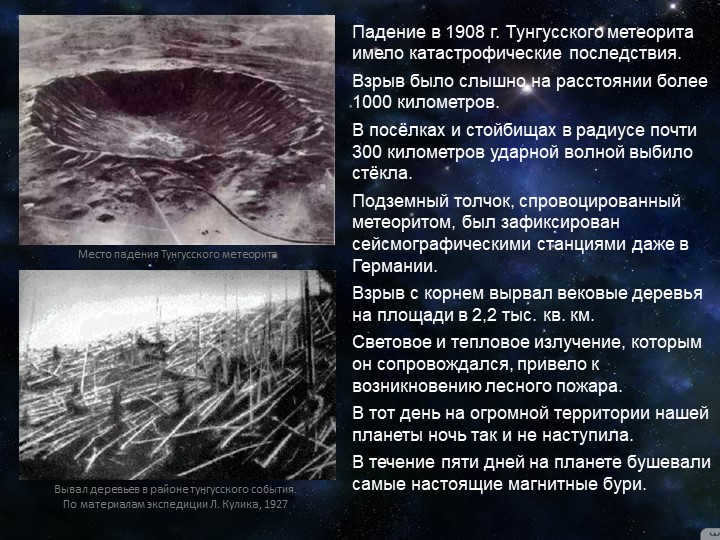
10 slides documenting the fallen trees near the Tunguska event.
Based on the findings from L. Kulik’s 1927 expedition.
Location of the Tunguska meteorite impact.
The impact of the Tunguska meteorite in 1908 had devastating consequences.
The explosion could be heard over a distance of 1000 kilometers.
The shock wave shattered windows in settlements and camps within a radius of nearly 300 kilometers.
The underground shock caused by the meteorite was even detected by seismographic stations in Germany.
The explosion uprooted ancient trees across an area of 2,200 square kilometers.
The accompanying light and heat radiation sparked a forest fire.
On that day, darkness never fell over a vast region of our planet.
For five days, intense magnetic storms raged across the globe.
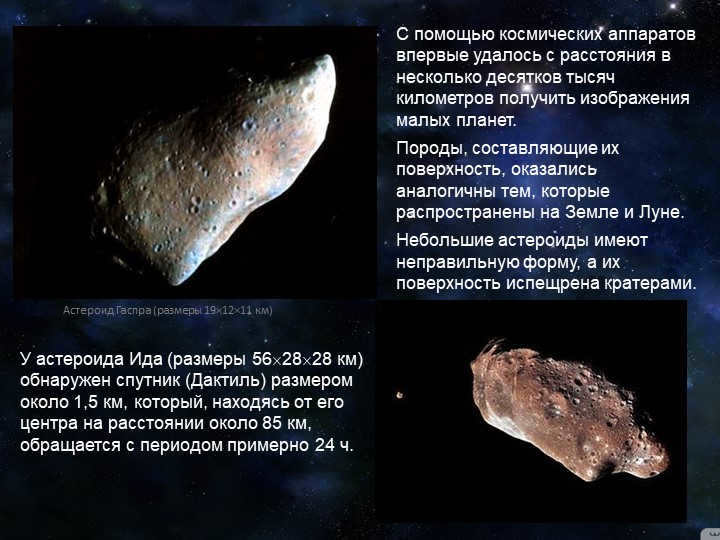

Slide 11: Using spacecraft, scientists were able to capture images of small planets from a distance of several tens of thousands of kilometers for the first time. These planets have rocks on their surface that are similar to those found on Earth and the Moon.
The surface of these small asteroids is characterized by irregular shapes and is covered in craters.
Asteroid Ida, which measures 562828 km, was discovered to have a satellite named Dactyl, which is approximately 1.5 km in size and orbits around Ida at a distance of about 85 km. This satellite has a period of about 24 hours.
Asteroid Gaspra, measuring 191211 km,
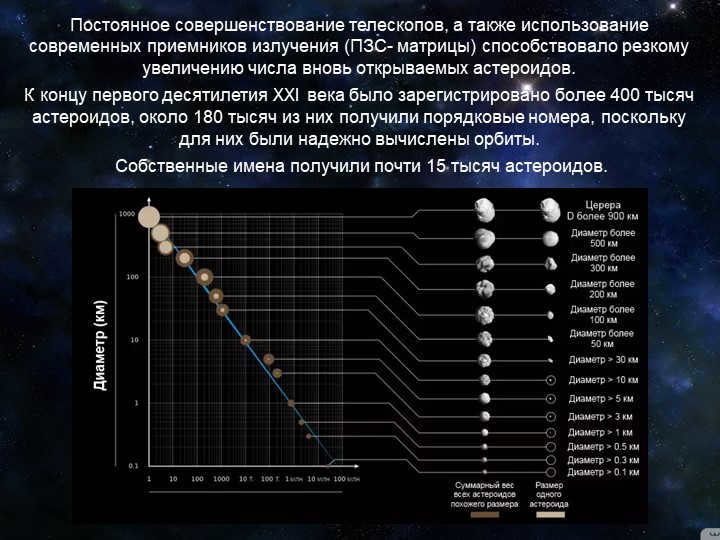
The continuous advancement of telescopes, along with the utilization of state-of-the-art radiation receivers (such as CCD matrices), has significantly contributed to a substantial rise in the number of recently discovered asteroids. By the conclusion of the first decade of the 21st century, over 400,000 asteroids had been recorded, with approximately 180,000 of them being assigned serial numbers due to the accurate calculation of their orbits. Furthermore, nearly 15,000 asteroids have been given individual names.
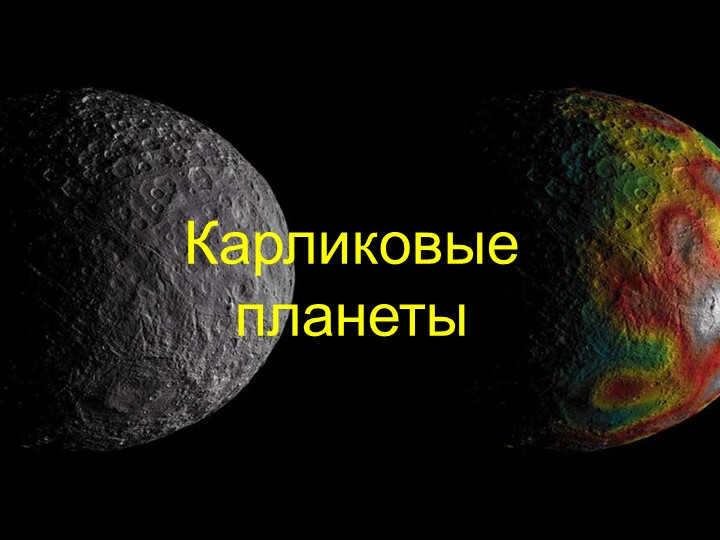
Slide 14: In 1930, the planet Pluto was first observed beyond the orbit of Neptune, approximately 40 astronomical units away.
Pluto is unique in size and mass, being smaller than Earth’s Moon, and it also has a distinctive density compared to other planets in our solar system.
A major discovery was made in 1978 when scientists found that Pluto has a large moon called Charon.
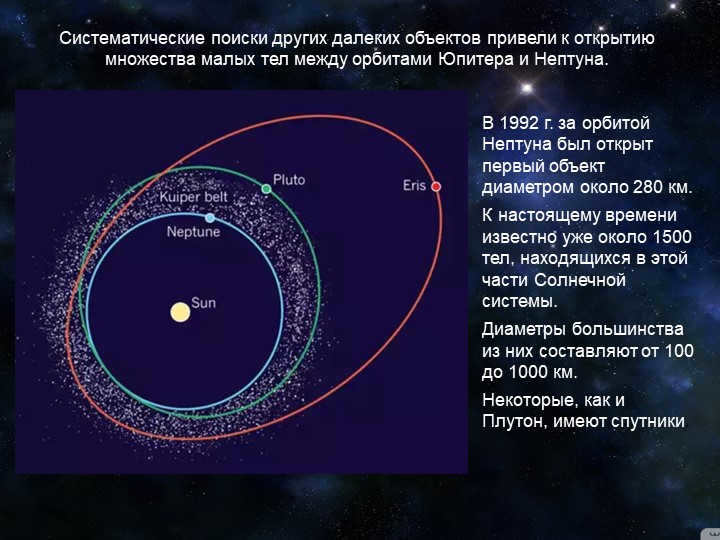

The discovery of many small bodies between the orbits of Jupiter and Neptune has been made possible through systematic searches for other distant objects. In 1992, the first object with a diameter of approximately 280 km was found beyond the orbit of Neptune. At present, there are already around 1500 known bodies in this region of the solar system. Most of them have diameters ranging from 100 to 1000 km. Some of these bodies, such as Pluto, have satellites.
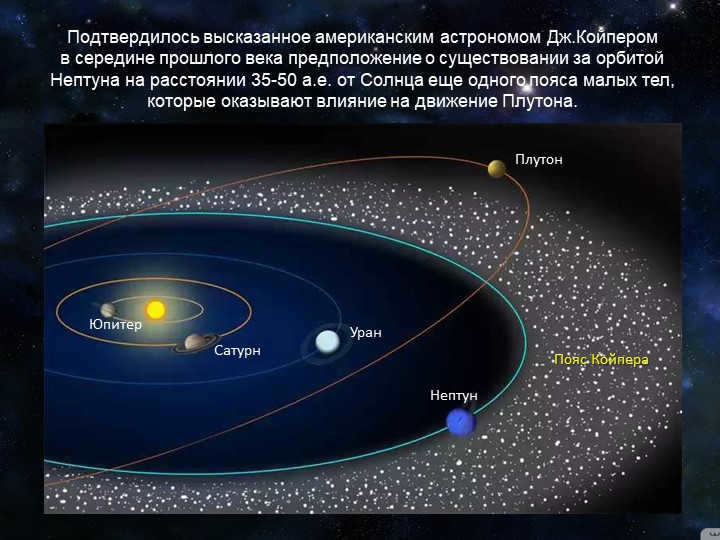

Slide 16: The theory proposed by J. Kuiper, an American astronomer, in the mid-20th century regarding the presence of a belt of small objects beyond Neptune’s orbit, approximately 35-50 a.u. away from the Sun, which affects the movement of Pluto, has been validated.
Neptune
Pluto
Uranus
Saturn
Jupiter
Kuiper Belt
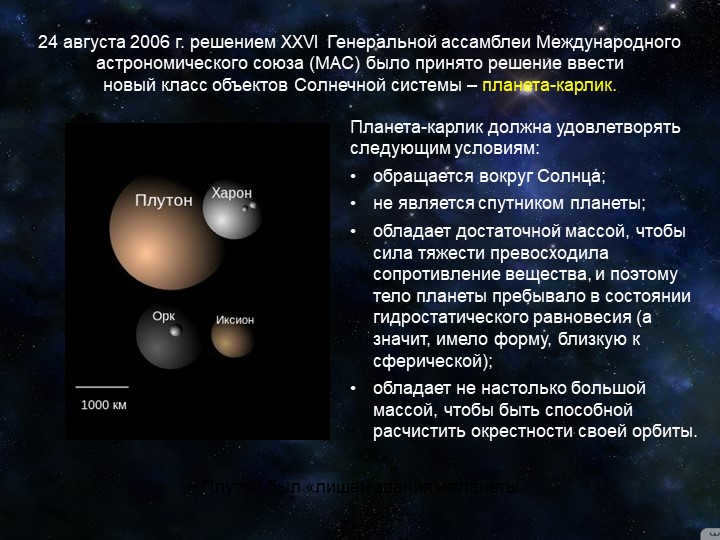
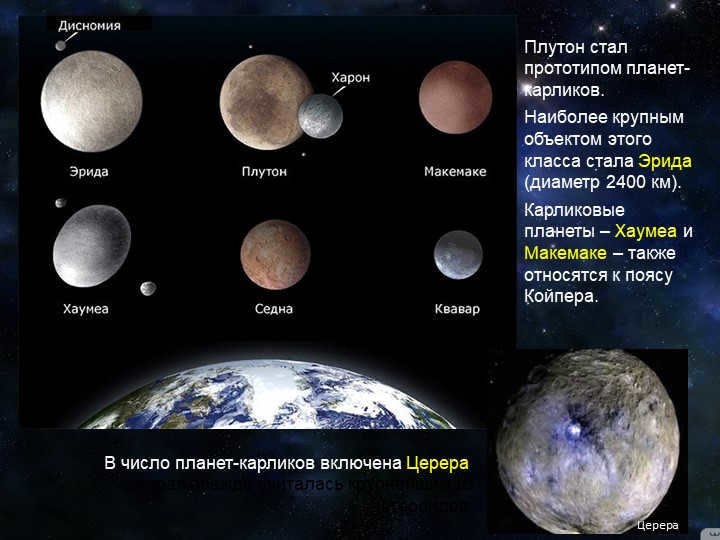
Pluto, with its 18 slides, served as the model for dwarf planets.
Among the members of this group, the largest one is Erida, measuring 2400 km in size.
Two other dwarf planets, Haumea and Makemake, are also part of the Kuiper belt.
Previously thought to be the largest asteroid, Ceres is now classified as a dwarf planet.
Ceres
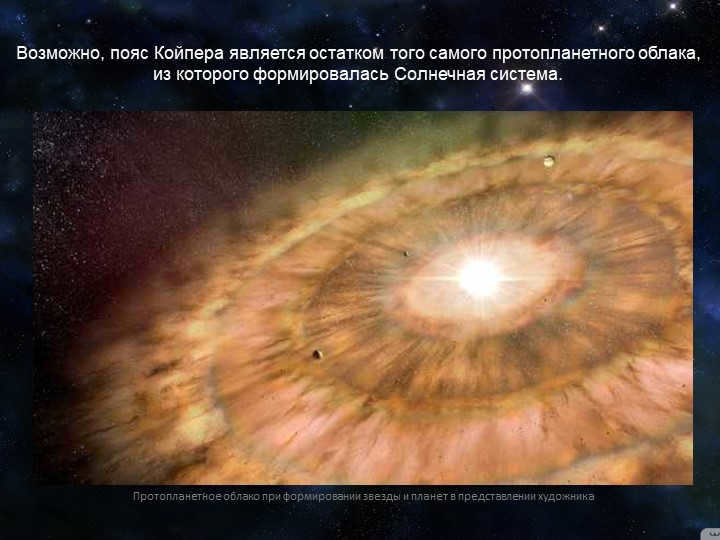
Slide 19: There is a possibility that the Kuiper belt is a leftover fragment of the original protoplanetary cloud that gave birth to our solar system.
Artist’s depiction of a protoplanetary cloud during the formation of stars and planets.
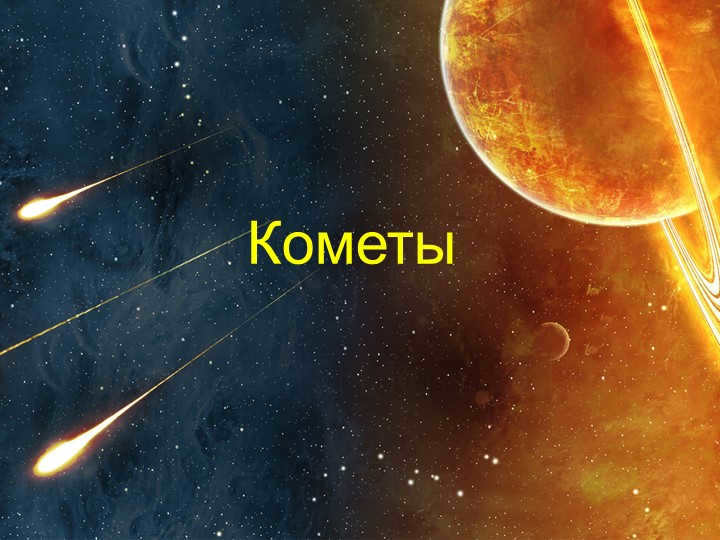
Slide 21: Comets have captivated the interest of people, regardless of their familiarity with astronomy, throughout history due to their distinctive appearance, particularly the tail that can span multiple constellations.
Throughout the entire observation period, over 2000 comets have been documented and studied.
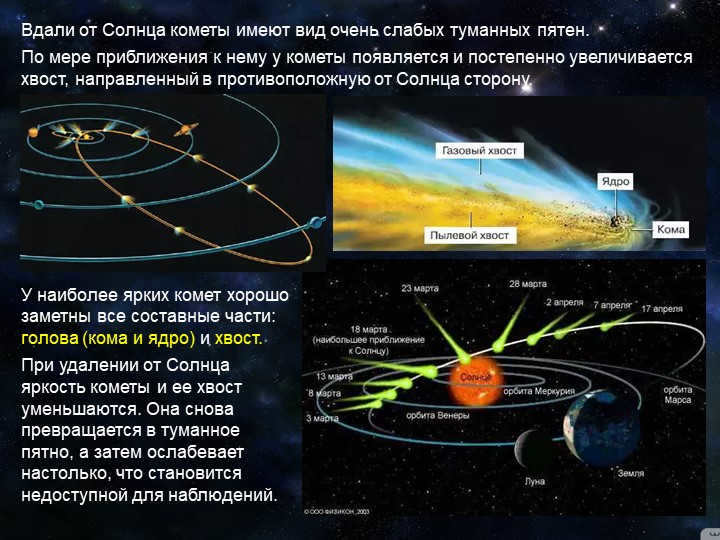
When comets are far away from the Sun, they have the appearance of faint foggy spots. However, as they approach the Sun, a tail starts to form and gradually becomes more prominent, pointing in the opposite direction. The brightest comets display all their components, including the head (coma and nucleus) and tail. As the comet moves away from the Sun, its brightness and tail diminish. Eventually, it becomes a nebulous blur again and fades to the point of being unobservable.
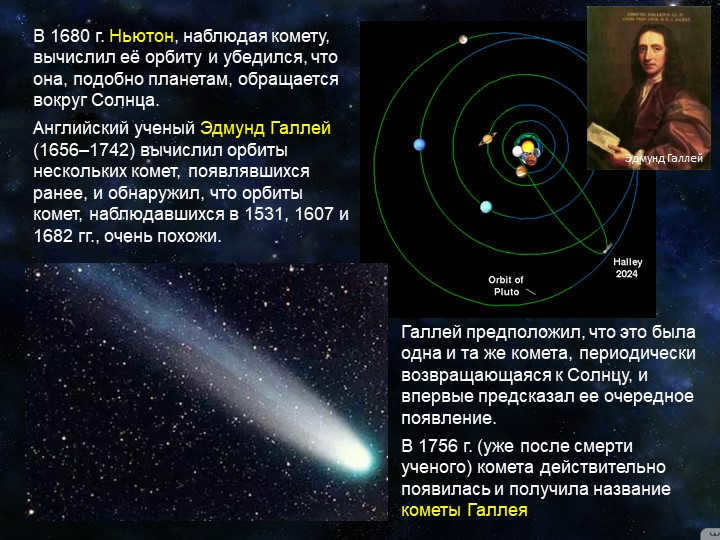
In 1680, Newton made an observation of a comet and used his calculations to determine that it orbited the Sun, similar to the planets. The English scientist, Edmund Halley (1656-1742), analyzed the orbits of various comets that had been seen before and discovered that the orbits of the comets observed in 1531, 1607, and 1682 were remarkably alike. Halley speculated that these comets were actually the same one, making periodic returns to the Sun. He then made the first prediction of its next appearance. After Halley’s death in 1742, the comet did indeed reappear in 1756 and was subsequently named Halley’s Comet in his honor. Edmund Halley was a significant figure in the field of astronomy.
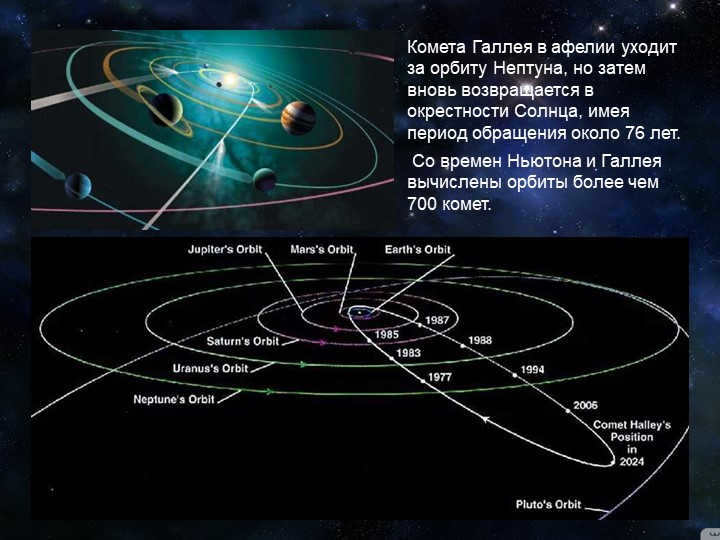

Halley’s Comet, with an orbital period of approximately 76 years, ventures past the orbit of Neptune during its aphelion before making its way back towards the Sun. This celestial phenomenon has been observed and studied since the time of Newton and Halley, and scientists have calculated the orbits of over 700 comets.
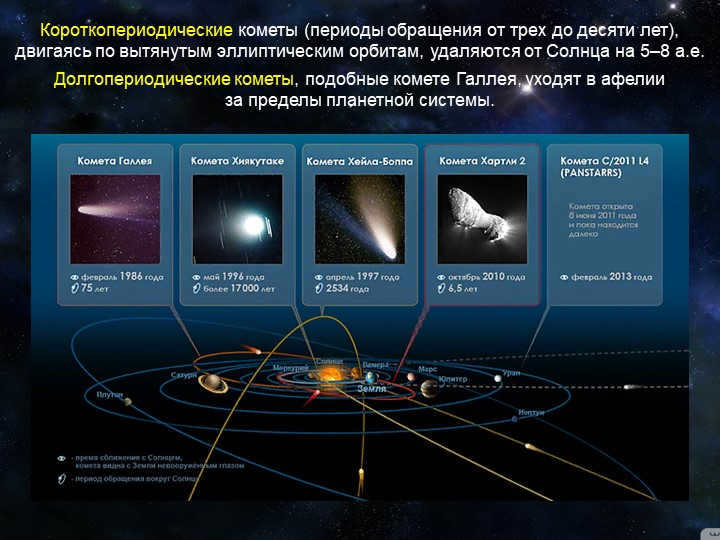
Short-period comets, which have orbital periods ranging from three to ten years, travel along elongated elliptical paths and move away from the Sun by a distance of 5-8 astronomical units.
On the other hand, long-period comets, such as Halley’s Comet, reach their farthest point from the Sun, known as aphelion, beyond the boundaries of the planetary system.
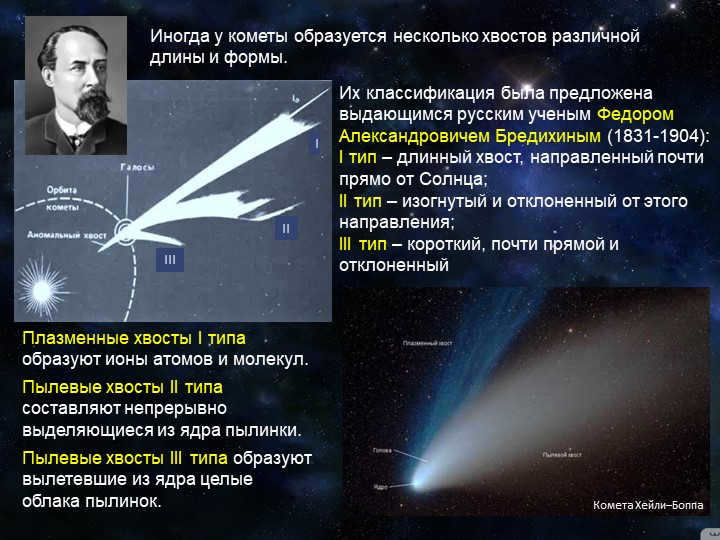
Slide 26 presented the classification of asteroids that was suggested by the renowned Russian scientist Fyodor Alexandrovich Bredikhin (1831-1904). The classification includes three types:
Type I – characterized by a long tail that points almost directly away from the Sun;
Type II – has a curved shape and deviates from the aforementioned direction;
Type III – features a short, almost straight tail that is also deflected;
An example of a comet that falls under Type I is Comet Hale-Bopp.
Type I plasma tails are formed by ions of atoms and molecules, while Type II dust tails consist of dust particles continuously emitted from the nucleus. Type III dust tails, on the other hand, are comprised of entire clouds of dust particles that escape from the nucleus.
In some cases, a comet may develop multiple tails that vary in length and shape.
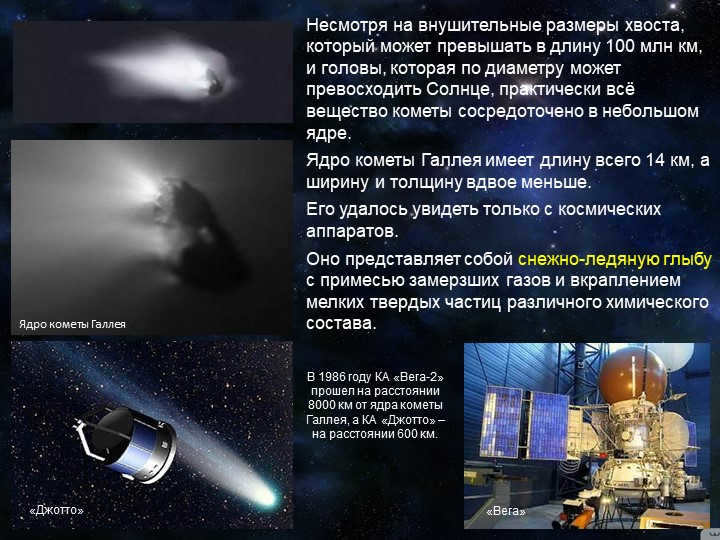
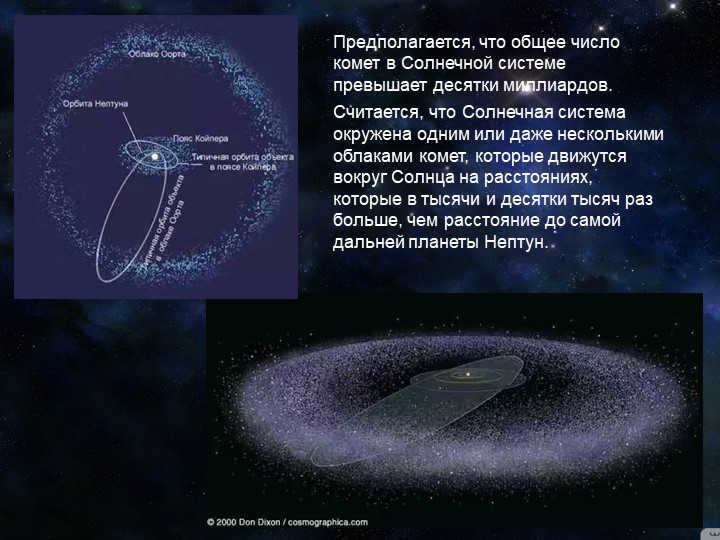
It is estimated that there are more than tens of billions of comets in the solar system.
Researchers believe that there are one or even multiple clouds of comets surrounding the Sun, orbiting at distances that are thousands and even tens of thousands of times greater than the distance to Neptune, the farthest planet in our solar system.
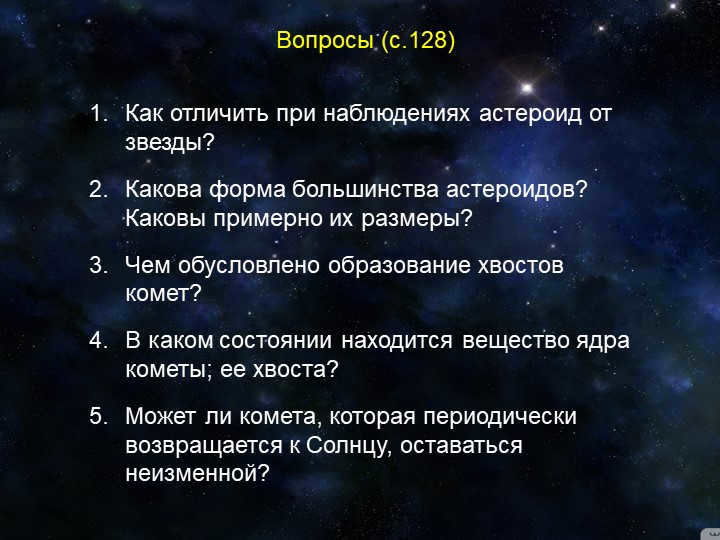
Slide 29 Questions (p.128)
How can one differentiate between an asteroid and a star while observing them?
What is the typical shape of asteroids? What are their approximate sizes?
What causes the formation of comet tails?
In what state does the matter of a comet’s nucleus and its tail exist?
Can a comet that periodically returns to the Sun remain unchanged?
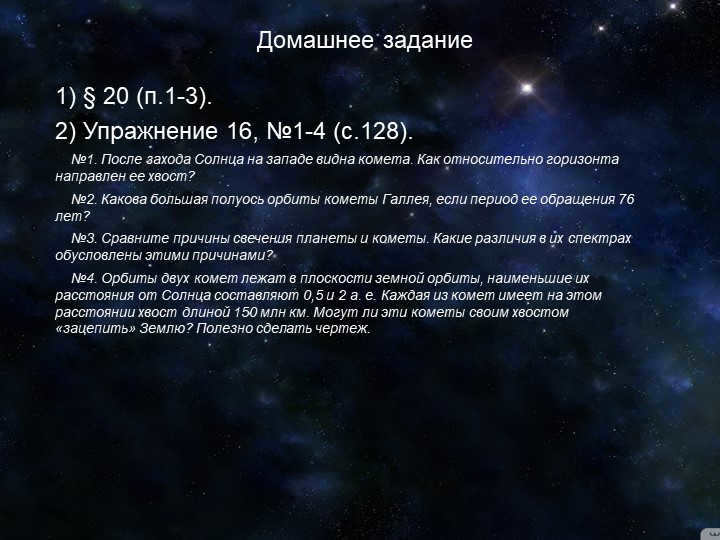
Asteroids are celestial bodies that revolve around a central star in the solar system. They are significantly smaller and less massive than planets, lacking an atmosphere and exhibiting an irregular shape. The exploration of asteroids holds significant scientific and practical value, as some of them present a potential threat to our planet. Understanding the nature of asteroids not only brings us closer to unraveling the enigma of life’s origins on Earth and the formation of the solar system, but also has the potential to safeguard human civilization.
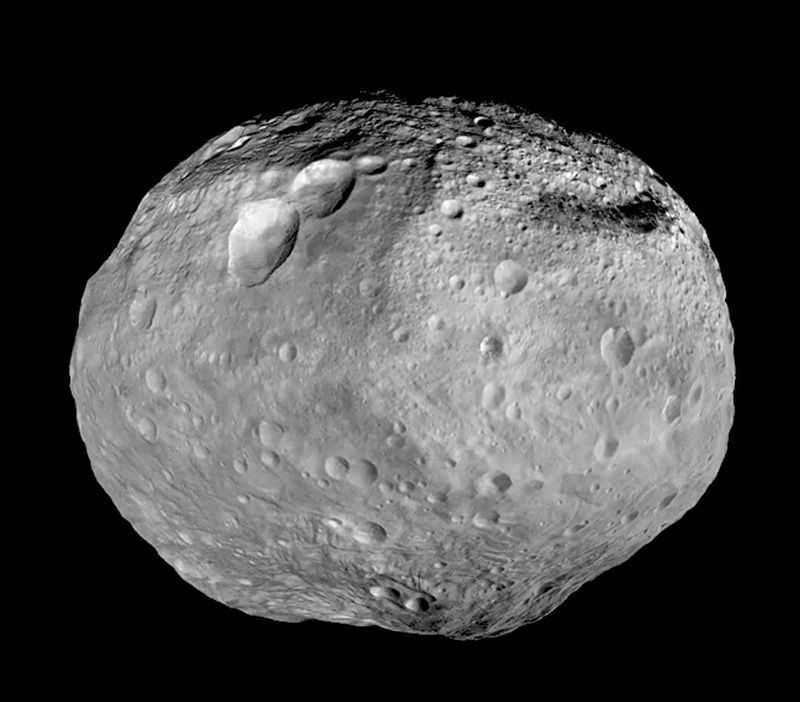
Asteroids in the Solar System
It is now understood that there are 670,000 asteroids in the solar system. Over 400,000 of them have known orbits and assigned identification numbers. Additionally, there are more than 19,000 asteroids that have official names. It is estimated that there may be up to 2 million objects in the solar system with a diameter greater than one kilometer. The majority of these asteroids are found between the orbits of Mars and Jupiter, forming what is commonly known as the asteroid belt.
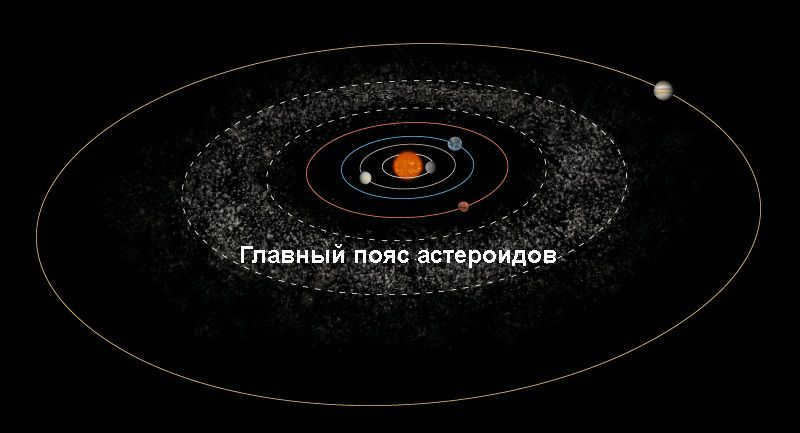
Asteroids Pallada and Vesta have a size of over 500 kilometers in diameter. Vesta is visible to the naked eye. The weight of the asteroid is approximately 950 quadrillion tons. Prior to 2006, the largest asteroid was Ceres. However, it was later reclassified as a dwarf planet. The combined weight of all these celestial bodies is more than 3 quintillion tons.
Etymology of the phrase
The phrase “asteroid” is derived from the combination of the words “star” and “species”. The literal translation signifies “resembling a star”. It was coined by the composer C. Burney and introduced into scientific circulation by W. Herschel. When observed through a telescope, these objects appeared as small star-like points, contrasting with the disk-like appearance of planets. Until recently, these objects were referred to as “small (dwarf) planets”.
Asteroids encompass celestial bodies with a diameter exceeding 30 meters. Smaller entities are known as meteoroids. They represent intermediate space bodies between space dust and asteroids. If a meteoroid enters the Earth’s atmosphere at high velocity, it disintegrates due to friction and incinerates.
The majority of the celestial bodies mentioned are small bodies within our solar system.
The process of naming asteroids
Initially, these entities were assigned names from ancient mythology. Subsequently, astronomers started naming new discoveries as they pleased. Initially, they were given women’s names, but asteroids with unique orbits started being assigned male names.
Only a named can be given to an asteroid whose orbit has been calculated and studied. This process can take several years, even decades. Until the exact orbit is determined, the celestial body is given an alphanumeric designation. The first letter represents the ordinal number of the half-month period in which the object was discovered. The second letter represents the ordinal number of the asteroid discovered in that half-month period. For instance, the alphanumeric designation 1991 EB indicates that the celestial object was discovered in 1991 during the first half of March, and it was the second asteroid discovered in that half-month period. The letters I and Z are excluded from the alphanumeric designations.
Asteroids came into existence through the gravitational pull of dust and gas, and they revolved around the Sun at a rapid pace in the initial phases of the solar system’s development. These celestial objects possessed sufficient mass to create a liquid inner core.
As Jupiter grew larger and attained its current mass, a substantial portion of the prospective protoplanets fragmented and were expelled from the initial asteroid belt that lay between Mars and Jupiter. Based on computer simulations, a few of these celestial bodies were retained in the Kuiper belt and the Oort cloud. It is probable that certain objects formed within the solar system were expelled beyond its boundaries, and now they roam freely in outer space.
Chemical composition, configuration, and dimensions of asteroids
In the early 19th century, German astronomers W. Herschel and I. Schröter initiated the first endeavors to ascertain the dimensions and shape of asteroids.
Contemporary astronomy employs various techniques to determine the dimensions of asteroids, including:
- polarimetry;
- radar;
- spectrum interferometry;
- transit;
- thermal radiometry.
Asteroids with diameters exceeding 500 kilometers are considered the largest. Nonetheless, the majority of objects belonging to this category have dimensions ranging from a few hundred meters to a few kilometers.
The majority of asteroids have an irregular configuration. This is attributed to the fact that the weak gravitational force is unable to shape them into a spherical form. Only the largest asteroids possess a spherical configuration (unless they have undergone collisions with similar bodies).
It is also worth noting that the luster of small objects decreases in proportion to the increase in phase angle, which further confirms their irregular shape.
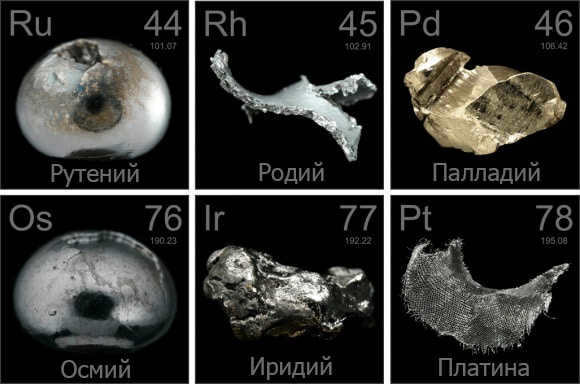
The majority of asteroids are primarily composed of carbon, with a lesser abundance of silicate and metallic materials. Metallic asteroids, categorized as class M, contain cobalt and nickel. Basaltic and olivine asteroids are relatively rare.
Orbital Classification
Asteroid classification plays a crucial role in their thorough examination. All known objects are organized into various groups and families based on shared characteristics:
All asteroids in the solar system orbit around the central star, typically exhibiting low eccentricity and inclination. The majority of asteroids are situated within the confines of the outer belt. These objects have an average rotational speed of approximately 20 kilometers per second and complete a full orbit around the Sun within a span of 3 to 9 years.
The rotation of small bodies is influenced by the gravitational pull of the planets, causing the orbits of asteroids to be deflected in various directions. Among the planets, Jupiter has the greatest impact on the motion of asteroids. When asteroids collide with each other, they can combine to form new celestial objects.
After the fragmentation of a large body, a family of asteroids is formed, consisting of members that share close orbits. The largest asteroid families include:
- Flores (comprising more than 7,500 objects);
- Vestas (with approximately 6 thousand members);
- Eunomia (consisting of 4.7 thousand asteroids);
- Eos (comprising 4.4 thousand asteroids).
Spectrum-based Classification
In 1975, a classification system based on the spectrum was created to categorize asteroids. Since then, this system has been continuously improved as scientists gather more information about the various small objects within our solar system.
| Class | Characteristics |
| A | Asteroids in this category have a reasonably high albedo and appear red in the visible part of their surface |
| B | These asteroids are similar to class C asteroids, but they cannot absorb wavelengths shorter than 0.5 microns. They have a higher albedo than carbon objects and their spectrum appears blue. |
| C | These asteroids are made of carbon. There are about 75 small objects in the solar system classified as such. |
| D | These asteroids have a low albedo of up to 0.05. They have a flat, red spectrum without any distinct lines. |
| E | These objects have a surface made of enstatite. |
| F | Similar to class B asteroids, but they do not show any traces of “water”. |
| G | These asteroids have a low albedo and absorb ultraviolet rays. |
| M | These asteroids consist of metal. |
| P | These asteroids have a red absorption spectrum without any clear lines. |
| S | These asteroids are made of silicate. |
| Q | The spectrum of these asteroids shows olivine and pyroxene lines. |
| R | Asteroids with a high albedo and a red absorption spectrum |
| T | These asteroids have a low albedo and a red absorption spectrum at a wavelength of 0.85 micrometers. |
| V | These asteroids are moderately bright and are composed of rock, silicates, and iron. However, they have a higher content of pyroxene. |
| J | These asteroids appear to have originated from the interior of Vesta. |
Exploration of Asteroids: A Brief History
The exploration of asteroids, celestial bodies found in the solar system, began after the remarkable discovery of the planet Uranus. In the late 18th century, a dedicated group of astronomers embarked on a mission to locate a planet that was believed to exist between Mars and Jupiter. Simultaneously, they aimed to calculate the precise coordinates of stars and constellations at a specific point in time, facilitating the identification of any displacements.
It was on the inaugural day of the new century, in 1801, when astronomer Piazzi made an extraordinary breakthrough by discovering the first asteroid, Ceres. This auspicious event marked the dawn of a new era in celestial exploration. Subsequently, other significant asteroids like Pallada, Juno, and Vesta were identified a few years later. Astonishingly, astronomers soon deemed the pursuit of asteroid discovery as futile and halted their research endeavors.
In 1848, Henke, a German astronomer, decided to continue the quest. After a gap of 38 years since the last asteroid discovery, a new small object named Asthea was found. This achievement motivated astronomers to step up their efforts, resulting in the discovery of at least one new asteroid every year (except in 1945).
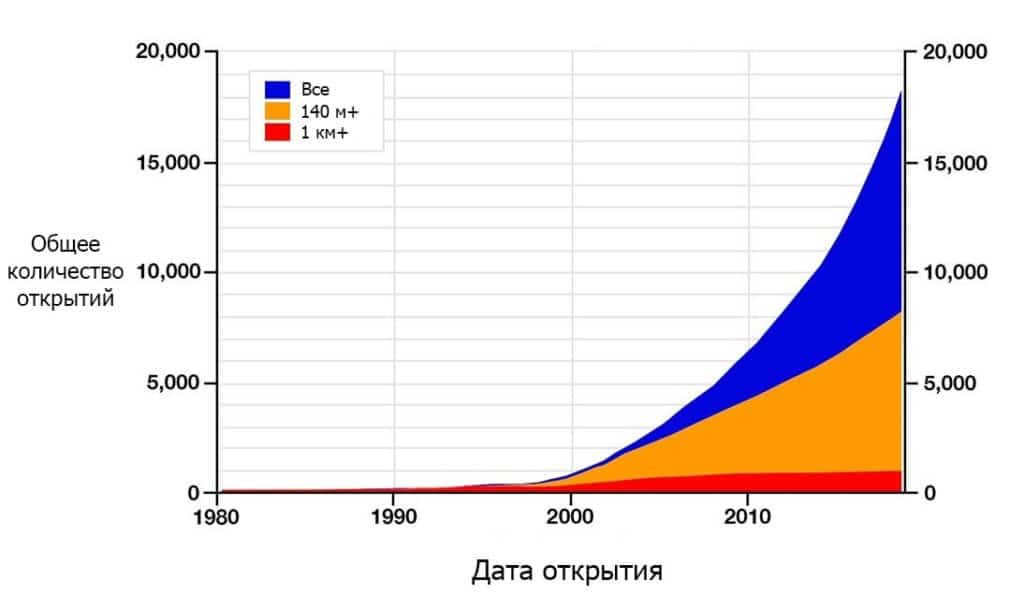
In the late 20th century, a novel technique of astrophotography was employed to search for unknown asteroids. This technique involved using ultra-long exposures, resulting in asteroids appearing as luminous streaks in the photographs. This ground-breaking method significantly expedited the process of asteroid discovery. As an illustration, Max Wolf, working independently without the assistance of a team of astronomers, successfully identified nearly two hundred and fifty asteroids.
The most massive asteroids in our solar system
Among the celestial bodies in our solar system, there are some incredibly large asteroids that stand out.
- One such asteroid is Pallada, which is composed mostly of silicon. It measures a whopping 532 kilometers in diameter and has a mass of approximately 210 quadrillion tons.
- Vesta, on the other hand, is the heaviest asteroid known to us. It has a diameter of 530 kilometers and its outer layer is made up of solid rock, while its core is composed of metal.
- Hygeia is another notable asteroid, known for its high carbon content. It has a diameter of 470 kilometers.
- Interamnia, classified as a rare spectral class F asteroid, has a diameter of 326 kilometers and a mass of 39 quadrillion tons.
- Europa follows an elongated orbit around the Sun. It measures 302 kilometers in diameter and has a mass of 16.5 quadrillion tons.
- Lastly, there is the asteroid Sylvia, which is unique for having two satellites. It has a diameter of 232 kilometers.
- Hector is made up of a combination of ice and rock and has a shape similar to that of a peanut. It has an average diameter of approximately 226 km and a mass of around 100 quadrillion tons.
- Euphrosyne has an average diameter measuring 255 km.
The Current State of Asteroid Research
Asteroid research plays a vital role in the field of science. It provides astronomers with valuable insights into the formation of the solar system and enhances our overall understanding of the universe and its various structures. A significant amount of effort from scientists is dedicated to analyzing the composition of asteroids.
Studying asteroids offers a unique opportunity to enhance our understanding of Earth and its origins. It is widely recognized that the current conditions on our planet can only be sustained due to the presence of a significant amount of liquid water. During the early stages of its formation, Earth was intensely heated, making it highly improbable for it to have developed vast reserves of water after cooling down. Initially, it was hypothesized that comets delivered water to Earth, but subsequent investigations revealed disparities in composition between Earth and comets.
It wasn’t until the early 21st century that scientists discovered ice deposits on one of the asteroids, Themis. This groundbreaking finding provided evidence that asteroids played a role in delivering water to Earth.
Scientists specializing in astronomy research asteroids within our solar system as a precautionary measure to detect and prevent potential threats. This is crucial because certain asteroids have the capability to pose a significant risk to our planet. The impact of an asteroid colliding with Earth could result in catastrophic and irreversible consequences. The portrayal of these potential scenarios can often be seen in numerous disaster movies.
One example of a potentially hazardous asteroid within our solar system is Apophis, which has a diameter of 325 meters. In 2029, it is projected to pass in close proximity to Earth, raising concerns about a potential collision in 2036. However, recent studies regarding the trajectory of this object provide reassurance that it is unlikely to pose a threat to our planet. The meticulous examination of such celestial bodies enables us to promptly detect and anticipate any impending danger originating from space.
Asteroid and comet threat
According to mathematical modeling, if the Earth were to collide with a 3 km diameter asteroid, it would result in a catastrophic cosmic event. The largest crater on our planet, which measures 300 km in diameter, was formed from a collision with a body no larger than 10 km in diameter.
Objects that pose a potential threat to Earth are those that can come within a distance of less than 7.5 million kilometers. The level of danger posed by an asteroid is assessed on a scale of 0 to 10. A score of 0 indicates that the object poses no danger to the planet, while a score of 10 means that the asteroid will inevitably collide with Earth and lead to the demise of humanity.
If an asteroid with a diameter of 10 km or greater collides with our planet, it will generate a massive atmospheric shockwave. This celestial object will also trigger seismic activity and massive tsunamis. The intense heat from the impact will ignite widespread fires across the globe. These fires will release soot into the atmosphere, resulting in a darkening of the Sun. This will initiate a period of extreme cold that will prove fatal for all living organisms.
NASA has confirmed that there is no possibility of the asteroid Apophis colliding with Earth. This conclusion was reached after analyzing data gathered during a detailed observation of the object in January 2013, when it passed within approximately 14 million kilometers of our planet.
It is now established that all asteroids in the main belt are not a danger to Earth. The once concerning Apophis is no longer a threat to us.
In 2004, the celestial body known as 2004 FU162 came close to Earth, passing within a distance of 6,530 kilometers from our planet. While some asteroids have managed to penetrate the Earth’s atmosphere before, the gravitational forces caused them to break into smaller pieces and disintegrate in the air. However, in February 2013, a massive asteroid measuring approximately 17 meters in diameter and weighing around 10,000 tons made its way into the Earth’s atmosphere and detonated above the city of Chelyabinsk at an altitude of roughly 20 kilometers. This explosive event generated a powerful shockwave that shattered windows not only in the city but also in nearby settlements.
For centuries, humanity has been fascinated by small celestial bodies. Currently, there are tens of thousands of known asteroids orbiting in the main belt around the Sun. The examination of these entities holds significant practical value as it offers a potential solution to the energy and raw materials crisis. Furthermore, understanding the orbits of these objects can help prevent potential catastrophes, as some of them pose a threat to Earth.

Currently, 58,742 educational institutions have access to additional cumulative discounts ranging from 2% to 25%. To determine the discount available to all staff members at your educational institution, please log in to your personal Infoworks account.


Professional growth program
Techniques and Instruments for Integrating Business Technologies in Education
We can apply your educational institution’s discount to this offer (the amount depends on the number of your colleagues who have completed Infowrok courses).
Currently, there are additional discounts (ranging from 2% to 25%) available for 58,742 educational institutions. To determine the discount applicable to all staff members of your educational institution, please log in to your personal Infoworks account.


Course for professional growth
How to organize the work of a teacher specializing in children with intellectual disabilities
We have the ability to combine your educational institution’s discount with this special offer (this depends on how many of your colleagues have completed Infoworks courses)
Currently, 58,742 educational institutions are benefitting from additional discounts (ranging from 2% to 25%). To determine the discount that applies to all staff members of your educational institution, please log in to your personal Infoworks account.


Urban Ecology: Exploring the City as an Ecosystem
Breakdown of the Presentation by Individual Slides:

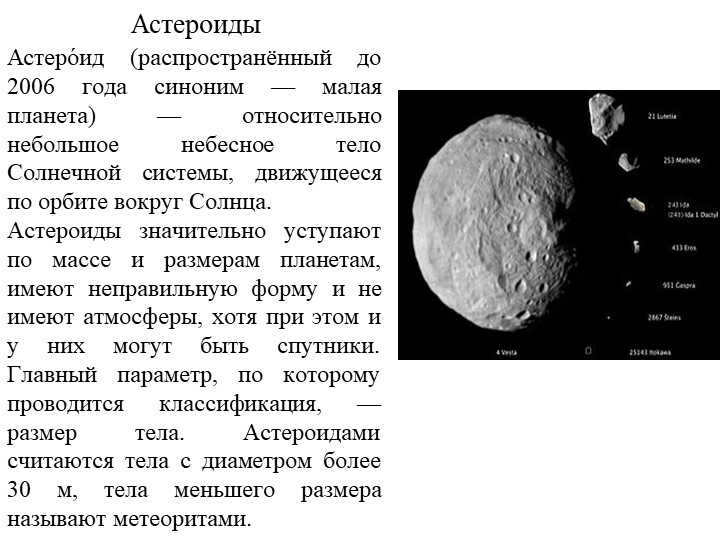
There are 3 slides about Asteroids.
An asteroid, also known as a small planet until 2006, is a small celestial object that orbits the Sun in the Solar System.
Asteroids are much smaller and less massive than planets, and they have an irregular shape and no atmosphere. However, some asteroids may have satellites. The primary factor used for classification is the size of the body. Bodies with a diameter greater than 30 meters are considered asteroids, while smaller bodies are known as meteorites.
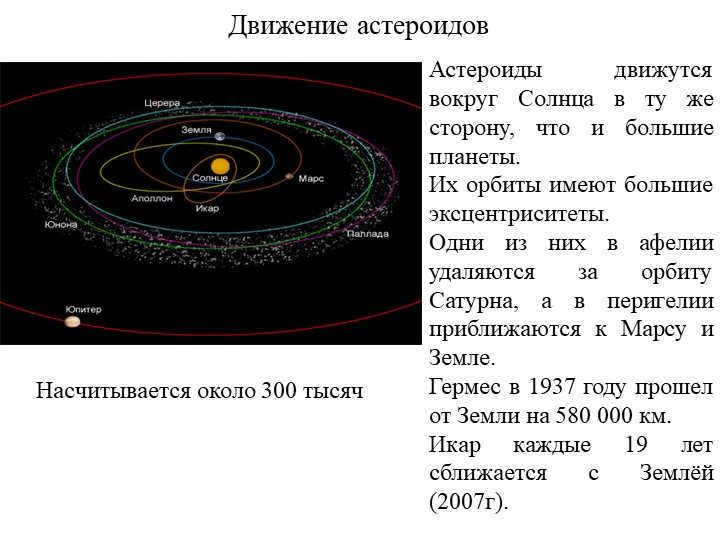
Slide 4 The movement of asteroids
Asteroids orbit the Sun in a similar direction as the larger planets.
Their orbits have significant eccentricities.
Some of them extend beyond Saturn’s orbit at aphelion and come close to Mars and Earth at perihelion.
In 1937, Hermes traveled a distance of 580,000 kilometers from Earth.
Every 19 years (2007), Icarus comes very close to Earth.
There are approximately 300,000 of them.
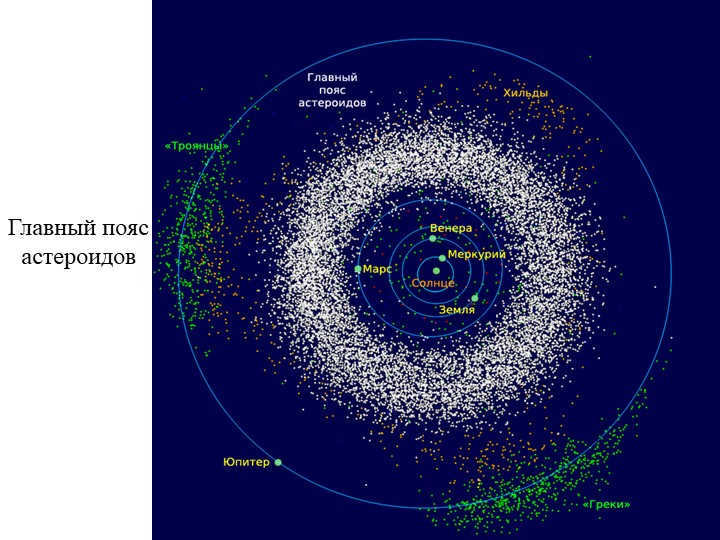
Slide 6: The biggest asteroids
Measuring approximately 950 km in diameter, Ceres stands as the largest and most substantial entity within the asteroid belt. Its size surpasses that of numerous large moons orbiting gas giants and accounts for almost a third (32%) of the belt’s overall mass.
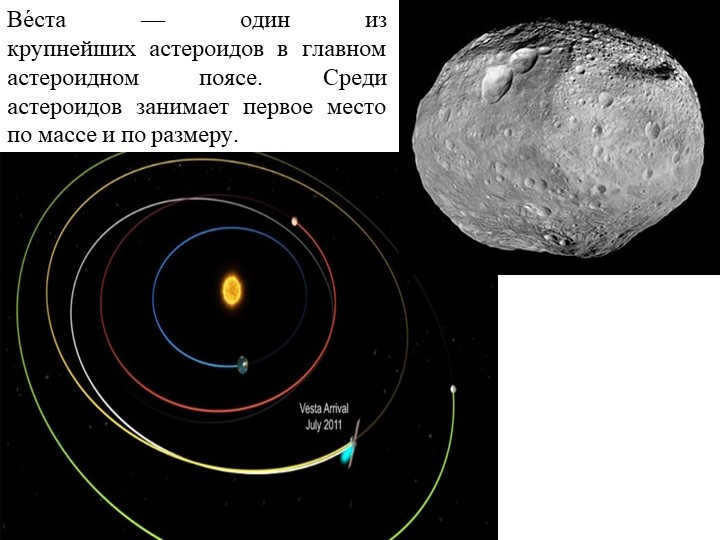

The majority of asteroids in the main asteroid belt have a different form, but Vesta stands out as one of the largest. In terms of mass and size, Vesta ranks first among all the asteroids.
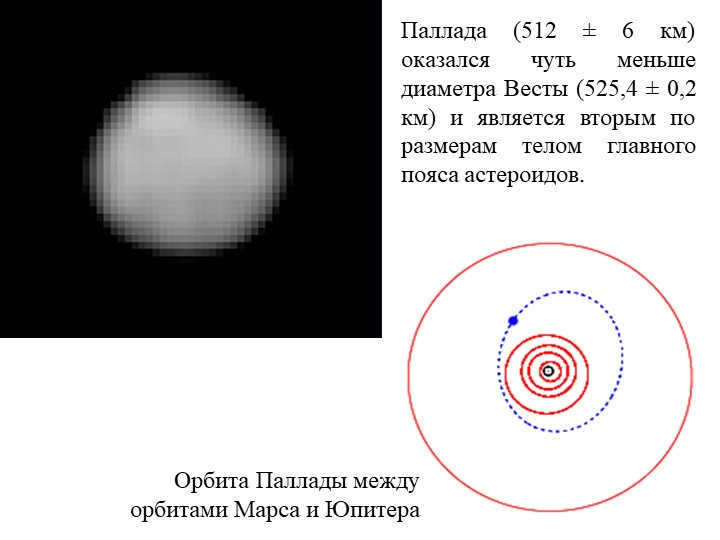
On the eighth slide, Pallada (512 ± 6 km) was just a little bit smaller than Vesta (525.4 ± 0.2 km) in diameter and it is the second largest object in the main belt of asteroids. Pallada’s orbit is situated between the orbits of Mars and Jupiter.
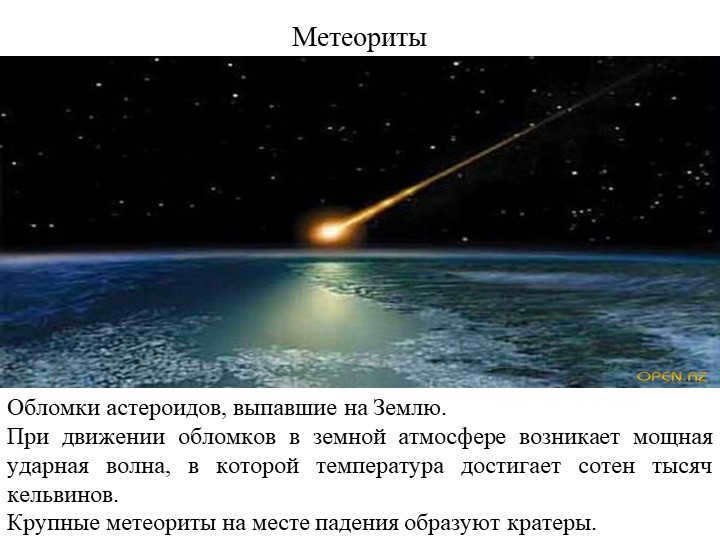
Slide 9: Meteorites
Meteorites are fragments of asteroids that have descended to the surface of our planet.
As these fragments journey through the Earth’s atmosphere, they generate an intense shock wave, causing temperatures to soar to hundreds of thousands of kelvins.
Upon impact, large meteorites create craters at the location of their fall.
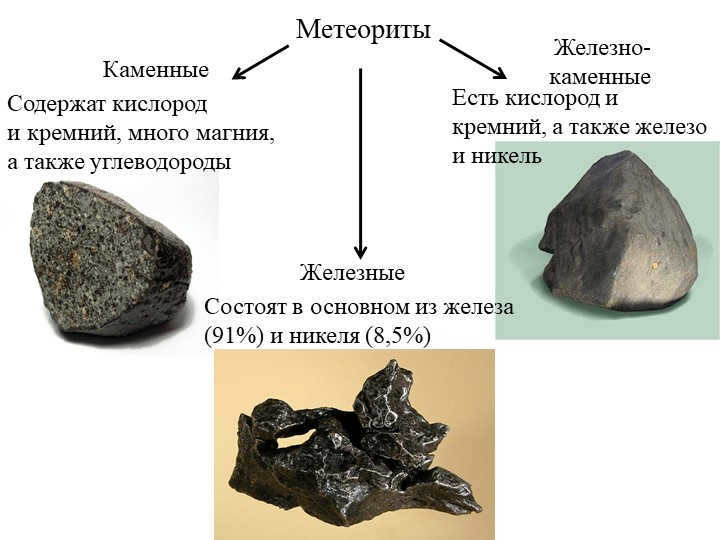

Slide number 10: Meteorites
Rock
Iron
Iron-rock
They are primarily composed of iron (91%) and nickel (8.5%)
They contain oxygen and silicon, along with a significant amount of magnesium and hydrocarbons.
There is also oxygen and silicon present, in addition to iron and nickel.
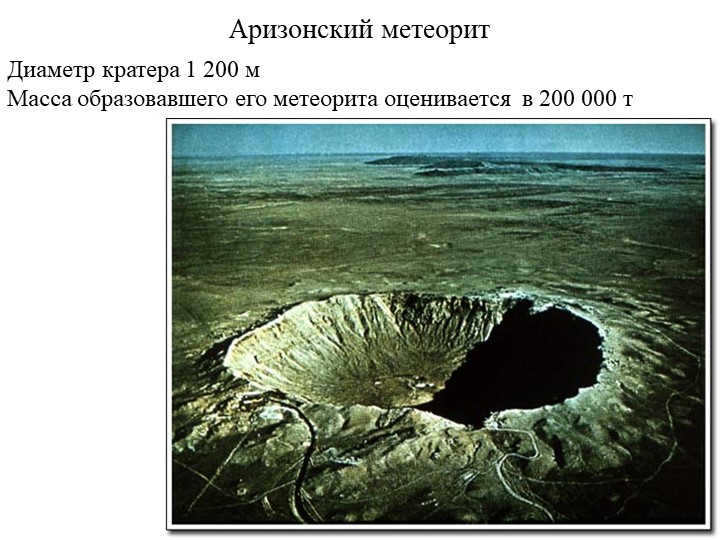
11th slide of the Arizona meteorite
The size of the impact crater measures 1,200 meters in diameter
The estimated weight of the meteorite responsible for its formation is around 200,000 tons.
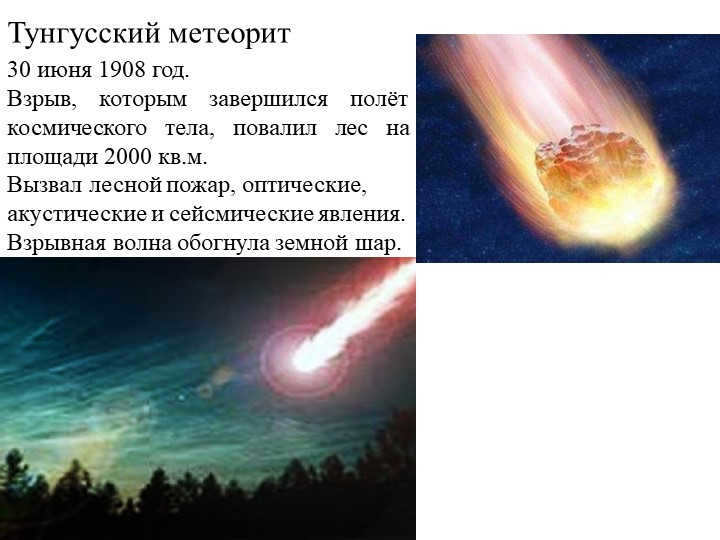

The Tunguska meteorite, which occurred on June 30, 1908, resulted in the cessation of the space object’s flight and the destruction of a forest spanning an area of 2,000 square meters. The event also triggered forest fires, as well as optical, acoustic, and seismic phenomena. Furthermore, the explosive wave propagated around the entire globe.
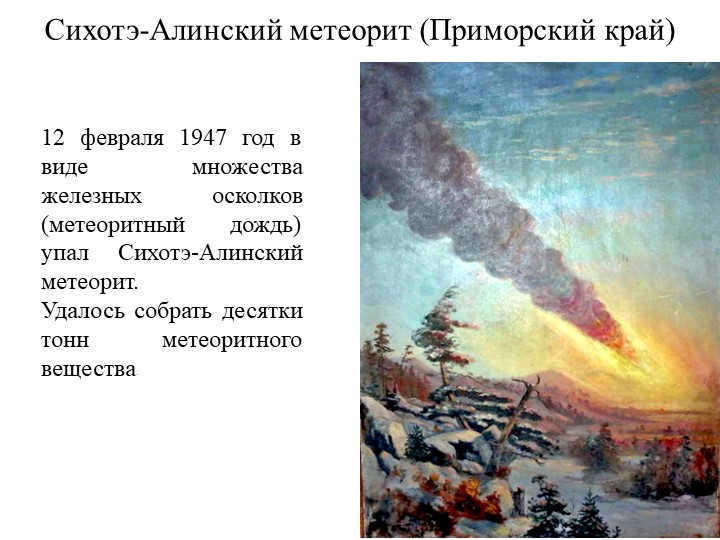
Slide 13 Sikhote-Alin meteorite (Primorsky Krai)
On February 12, 1947, the Sikhote-Alin meteorite descended in the shape of multiple iron fragments (meteor shower).
A considerable amount of meteoric material was gathered.
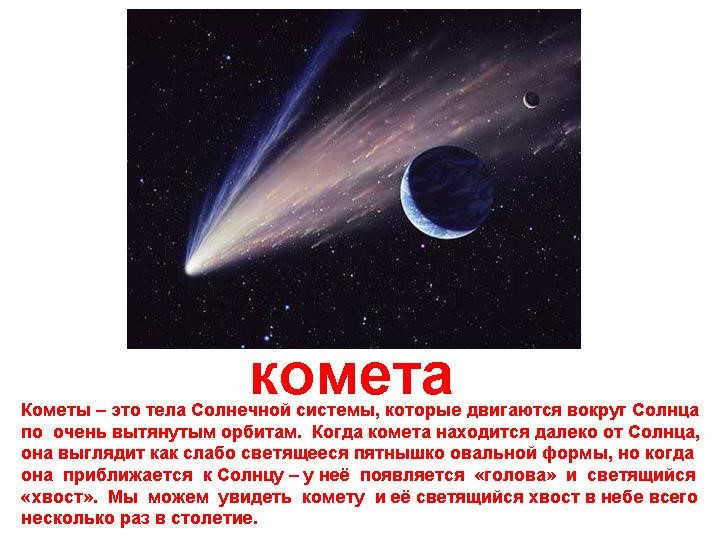
Comets are celestial objects that have a distinctive feature – a tail. They consist of three main parts: the head, the nucleus, and the tail. The nuclei of comets are similar in size to small asteroids. The head of a comet can reach a diameter of hundreds of thousands of kilometers, while its tail can extend for tens and even hundreds of millions of kilometers.
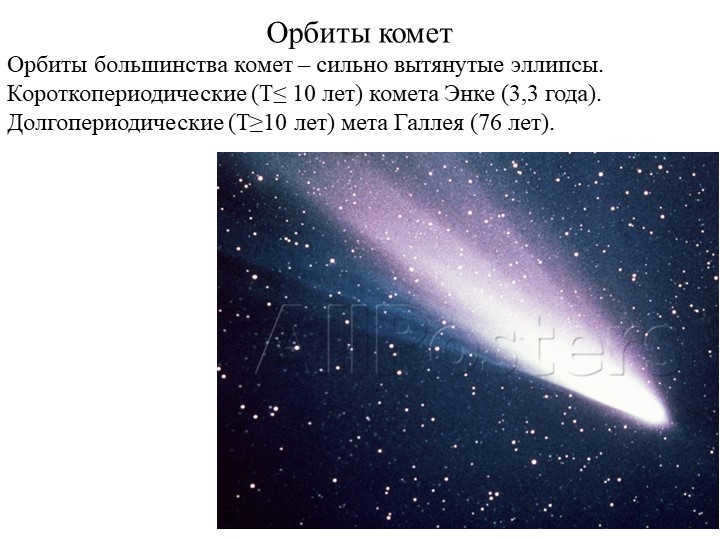
There are 16 slides that show the paths of comets in space.
Most comets have orbits that are elongated ellipses.
One example is the Enke comet, which completes its orbit every 3.3 years.
Another example is Halley’s comet, which has a orbit that takes 76 years to complete.
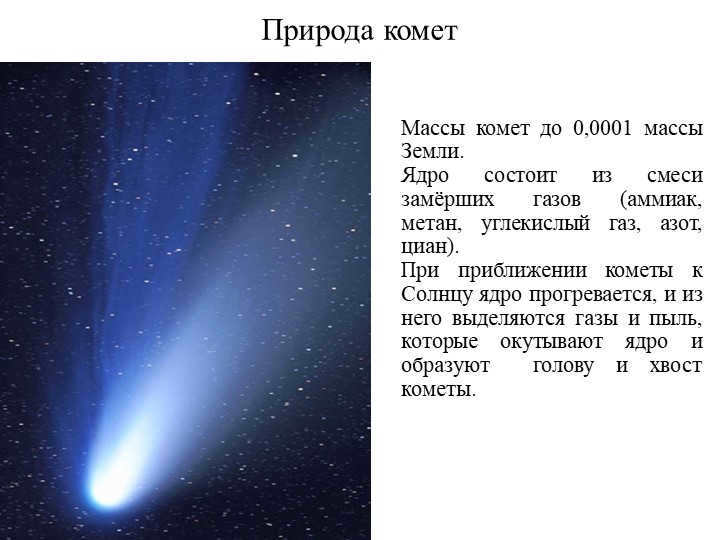
Slide 17: Characteristics of Comets
Comets have masses that can reach up to 0.0001 times the mass of Earth.
The nucleus of a comet is composed of a combination of frozen gases, including ammonia, methane, carbon dioxide, nitrogen, and cyanogen.
As a comet approaches the Sun, the nucleus heats up and releases gases and dust, creating a glowing head and tail around the nucleus.
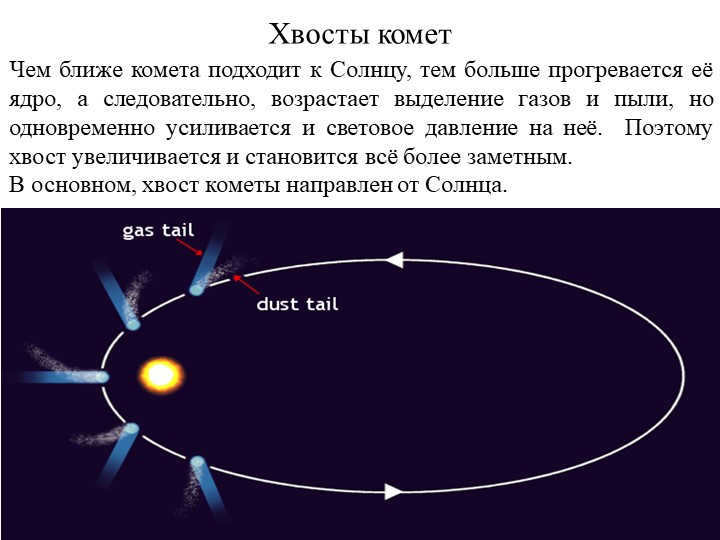
Slide 18: The Formation of Comet Tails
As a comet approaches the Sun, its nucleus heats up, causing an increase in the emission of gases and dust. This increase in emission, coupled with the pressure from sunlight, results in the expansion and visibility of the comet’s tail.
Typically, the comet’s tail extends away from the Sun.
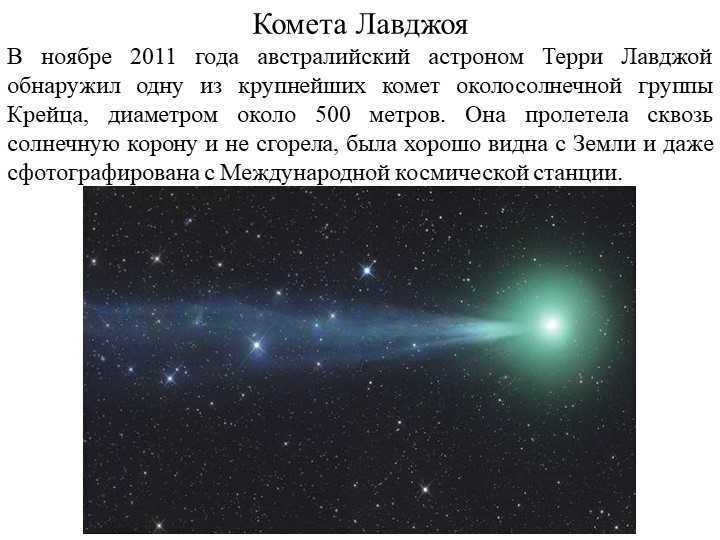

On the 19th slide, Comet Lovejoy was observed. In November 2011, Terry Lovejoy, an astronomer from Australia, made an exciting discovery of one of the largest comets in the Kreutz group, which orbits close to the sun. This comet had a diameter of about 500 meters and managed to pass through the solar corona without being destroyed. It was so bright that it could be seen from Earth, and it was even captured in photographs taken from the International Space Station.
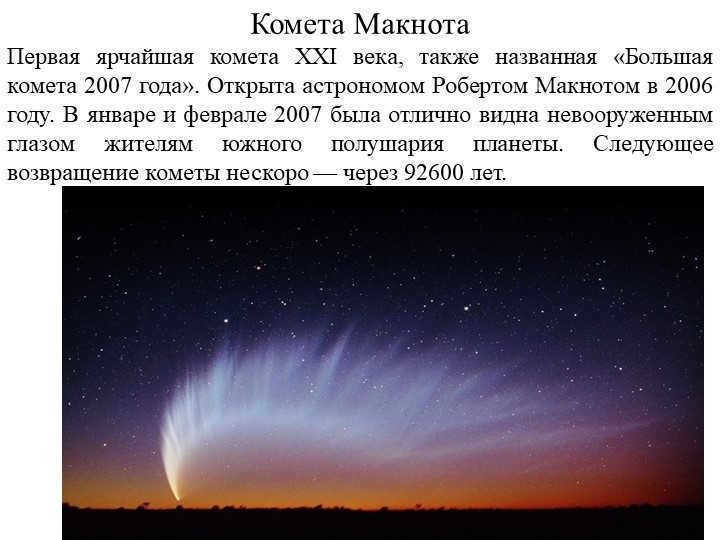
The 20 slide Comet McNaught is known as the Great Comet of 2007 and is considered the brightest comet of the 21st century. It was initially discovered by astronomer Robert McNaught in 2006. During January and February 2007, it was easily visible to the naked eye for people living in the southern hemisphere. Unfortunately, we will have to wait for its next return, which is not expected for another 92,600 years.
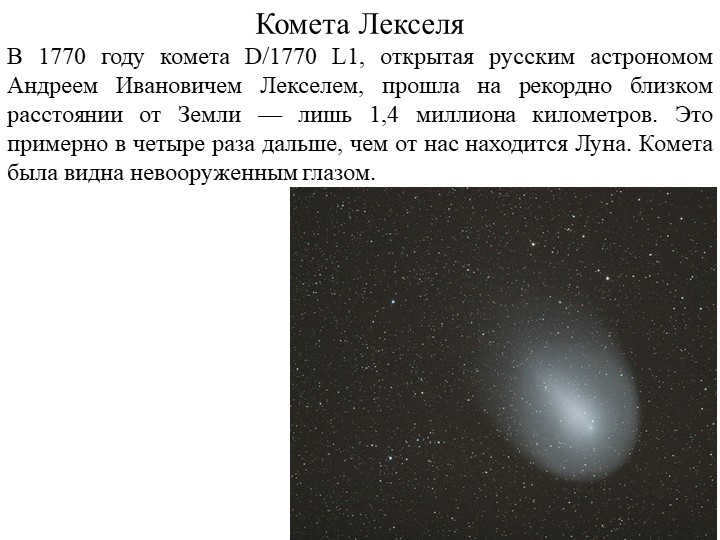

Slide 21, Comet Lexel
In the year 1770, a comet named D/1770 L1, was discovered by the renowned Russian astronomer Andrei Ivanovich Lexel. It passed by Earth at an extraordinary distance of just 1.4 million kilometers, which is approximately four times the distance between the Moon and our planet. This remarkable comet was even visible to the naked eye.


Halley’s Comet is the most renowned periodic comet, recognized for its regular appearances. It passes through the solar system every 75-76 years and can be easily observed with the naked eye. The English astronomer Edmund Halley was responsible for calculating its orbit and predicting its return in 1759. In 1986, a spacecraft was sent to explore the comet, gathering valuable information about its composition. The next sighting of Halley’s Comet is expected in 2061.
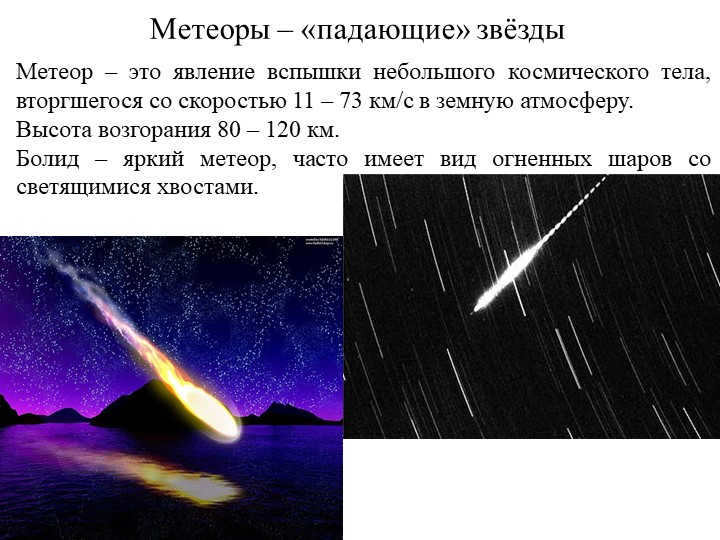
Slide 23: Meteors are commonly known as “shooting” stars.
A meteor refers to the occurrence of a small celestial body entering the Earth’s atmosphere with a velocity ranging from 11 to 73 km/s.
The altitude at which this phenomenon occurs ranges from 80 to 120 km.
A bolide, on the other hand, is a dazzling meteor that often takes the form of fireballs accompanied by luminous tails.
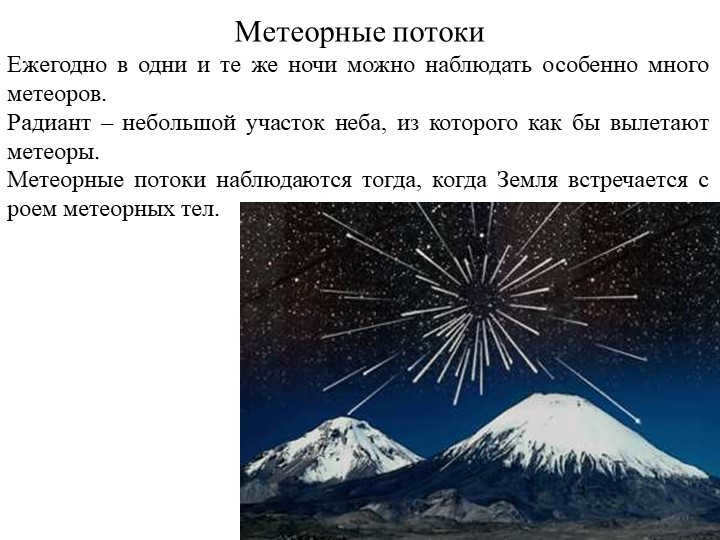
Slide 24 – Meteor Streams
Every year, on specific nights, a large number of meteors can be observed.
A radiant refers to a small area of the sky where meteors appear to originate from.
Meteor streams occur when the Earth encounters a cluster of meteoric bodies.

Slide 25 Control Questions
How can we differentiate between an asteroid and a star when observing them?
What is the typical shape of most asteroids? What are their estimated sizes?
What causes the creation of comet tails?
In what state does the matter of a comet’s nucleus and its tail exist?
Can a comet that returns to the Sun periodically remain unchanged?
A comet is visible in the western sky after sunset. In what direction does its tail extend relative to the horizon?
What are the different types of meteorites classified based on their chemical composition?
Can you assist me in answering these questions? I have a test tomorrow!
This is specifically for those who are new to astronomy and need a simple and understandable explanation. Feel free to read and comprehend the information provided. If you find anything confusing, please don’t hesitate to ask for clarification.
Can someone provide me with answers to these questions? I have a control test tomorrow!
1. How can you differentiate between an asteroid and a star in the celestial sky?
2. Elucidate the process of tail formation in comets. Why do comet tails point in the opposite direction of the Sun?
3. Where in the Solar System are the majority of asteroids’ orbits situated? How can this be rationalized?
4. Is there a distinction between a meteor, a meteorite, and a bolide? Elaborate on the essence of these disparities.
5. What are the trajectories of comets within the solar system? How can comets be categorized based on their paths?
6. What is the predominant shape of asteroids? How can this be explicated? In what groups can asteroids be classified?
7. What is the chemical composition of meteorites? Discuss the largest meteorites.
8. In what state does the substance constituting the nucleus and tail of a comet exist?
9. What phenomena are observed during the passage of cosmic-speed bodies through the Earth’s atmosphere?
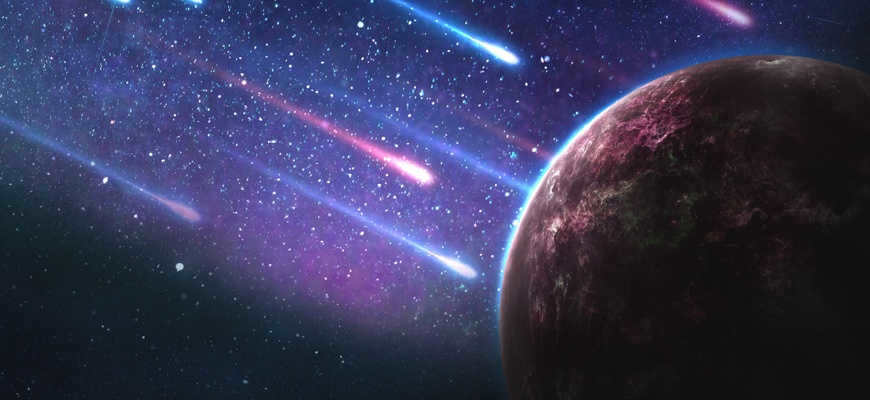
When gazing at the night sky, individuals are able to explore the universe, find inspiration, and simply relax. In this vast expanse, numerous luminous entities can be observed, including celestial bodies, planets, and asteroids. However, it is not always easy to differentiate between these objects. Hence, a logical and justifiable question arises: how can one distinguish an asteroid from a star during observations? This article will explore the key characteristics of both types of celestial bodies.
How to differentiate?
There exists a list of discernible and imperceptible disparities, which can be utilized in the procedure of attributing the entity to either one or another category. This will aid in addressing the query of how to differentiate an asteroid from a star during observations.
Star
- A star is a substantial celestial sphere that possesses the capacity to emit or reflect light. Its existence is upheld by thermonuclear fusion.
- This entity possesses a gravitational field, thereby enabling it to retain planets and smaller bodies of the system in close proximity.
- The star is comprised of a concentrated assemblage of chemical substances, perpetually evolving and imparting life to planets.
Visual Distinctions
When it comes to differentiating between an asteroid and a star, there are several visual factors to consider:
- Size characteristics (asteroids are generally smaller than stars, of course);
- Structural peculiarities;
- Composition nuances;
- Evolving capabilities (this phenomenon is most commonly associated with stars);
- Brightness of luminosity (it is easy to observe an asteroid passing by, while looking at the Sun without glasses is problematic).
Despite the available information, these celestial objects continue to captivate scientists and are the subject of ongoing research.
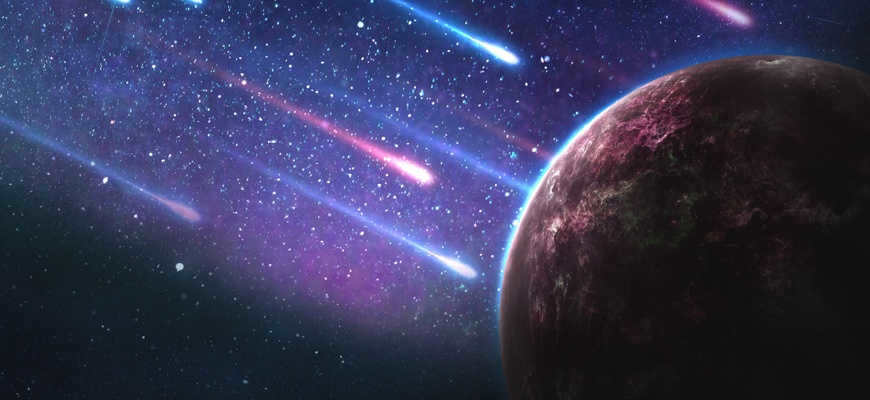

When we gaze at the night sky filled with stars, we often find ourselves unaware of the various celestial objects present. While stars are the most common, there are also asteroids, comets, meteors, planetary bodies, and cosmic dust that contribute to the brilliance. Differentiating between these objects can be challenging with the naked eye, but it is indeed possible. This article aims to provide you with the knowledge needed to determine whether you are observing a star or an asteroid in the night sky.
First, let’s clarify the terminology. For a considerable period of time, both the general public and the scientific community failed to differentiate between stars and asteroids, as well as asteroids and stars. This confusion persisted until 2006 when asteroids were officially reclassified from small planets to distinct celestial bodies. This reclassification was prompted by the realization that asteroids have a wide range of sizes, with diameters ranging from as small as 30 meters to as large as 900 kilometers. While asteroids are significantly smaller and less massive than planets, they do have the potential to have satellites. Furthermore, asteroids have an irregular shape, as they are composed of one or more metallic or mineral rocks, and they lack an atmosphere. It is worth noting that asteroids typically orbit around stars.
A star, in contrast, is a massive celestial body that emits or reflects light. Stars exist due to fusion reactions and are composed of a concentrated cluster of gases and abundant other elements. They have a spherical shape and emit tremendous amounts of heat and energy, serving as the cores of galaxies.
All the objects that one observes in the night sky full of stars appear somewhat alike: they are variously sized luminous dots, occasionally moving, falling, pulsating, shining brightly or dimly against the backdrop of others. Without the aid of a telescope, discerning the shape of an object becomes challenging, thus reliance must be placed on its size and brightness.
While a star map or constellation chart can be useful for navigating the stars, it is possible to identify objects without such assistance.
To differentiate between an asteroid and a star while observing the night sky with the naked eye, it is important to consider a range of visible and invisible distinctions. These distinctions can aid in classifying the object as a celestial body.
Star in the night sky:
- As previously mentioned, a star is significantly larger and more massive than an asteroid, and it has the capability to emit or reflect light. Due to its larger size, it appears visually larger in the night sky compared to an asteroid.
- A star has the ability to hold planets and smaller systems that may pass in front of the star, causing a slight flickering effect.
- A star appears significantly brighter compared to an asteroid.
- If a star disappears from its previous position, it can be either due to a shift in the star map caused by the Earth’s rotation, or the star’s light no longer reaching our planet. On the other hand, an asteroid constantly moves, and its trajectory can be tracked daily.
In the night sky, an asteroid:
By using a star map, you can exclude planets and stars from your observation list. Since asteroids are smaller objects, you can only observe them well when they are relatively close to Earth. This allows for a better estimation of their movement speed and appearance, even without additional tools such as a map, telescope, or photographic material.
Therefore, we have examined the indications and methods for distinguishing stars from asteroids while observing the celestial sky. To ensure accurate identification of the observed object, it is also possible to utilize specialized websites and software designed for observing the night sky.
P.S. I require responses to the inquiries by TODAY, VERY VERY VERY VERY VERY VERY VERY VERY VERY VERY VERY VERY VERY VERY VERY VERY VERY VERY VERY VERY VERY VERY VERY VERY VERY VERY VERY VERY VERY VERY VERY VERY VERY. PLEASE.
1. Asteroids do not emit light; instead, they merely reflect it and possess irregular shapes.
2. The tails of comets always face away from the sun due to the electromagnetic radiation emitted from its surface.
2. Because the comet is composed of ice, when it nears the sun, the ice melts and transforms into a substance that surrounds the ice. The solar wind then blows these dust particles in the opposite direction (I was aware of this fact, not obtained from websites).
3. No, the gravity on the moon is extremely weak.
1. Stars exhibit various colors, such as red, blue, orange, and red. On the other hand, asteroids are only yellow.
Without a telescope, there is hardly any way to observe these phenomena unless an asteroid approaches the Earth at an extraordinary speed. In such a case, the news would be broadcasted on all television channels! The tails of comets point away from the sun because they all move towards the sun and then away from it!
Accurate response.
An asteroid distinguishes itself from stars by its movement relative to them over time, much like planets do.
Comets develop tails as they approach the sun and these tails are pushed away from it due to light pressure and solar wind.
An asteroid is visibly in motion, especially evident in photos where it appears as a line in relation to the stationary stars. (The camera is mounted on a specialized instrument that rotates in sync with the daily rotation of the sky, capturing the asteroid at the correct angle based on latitude).
2. Not all comets have tails that point away from the sun. While most comets are affected by the solar wind, there are comets whose tails point towards the sun (possibly due to heavy dust) or, like the recent Holmes comet, expand uniformly in all directions.
Hello.
1. The brightest asteroid, Vesta, never shines brighter than a 6th magnitude star. The largest asteroid is Ceres, with a diameter of 780 km. Even with the most powerful telescopes, nothing can be seen on such a small disk beyond the orbit of Mars. The smallest known asteroids have diameters of just a few kilometers. Naturally, asteroids do not have atmospheres. On the celestial sphere, they appear like stars and only differ from them in their characteristic loop-like movement against the backdrop of the starry sky.
3. It is impossible to do so, as there is no atmosphere present.
1. Stars remain stationary in relation to each other, while the asteroid undergoes a slight shift in its position in the sky every day in relation to the stars. By capturing the same area of the sky on photographic plates daily and overlapping them, the stars will align, but the asteroid’s position will differ as it moves relative to the stars.
2. The tails of comets, not planets, point away from the Sun. Planets do not possess tails.
Comet tails point away from the Sun because the Sun’s heat causes the comet to vaporize. These vapors form the tail, which is subsequently pushed away from the Sun by solar radiation.
3. Meteors are not visible on the Moon due to its lack of atmosphere. A meteor is a luminous trail left by a meteorite as it incinerates in the Earth’s atmosphere and descends to the surface. It incinerates due to the resistance it encounters from the air while traveling at an incredibly high velocity. However, since the Moon lacks an atmosphere, meteorites do not incinerate or emit light, thus making meteors impossible to observe on its surface.
1. Motion. We capture a sequence of images of the same celestial region, create an animation from them, and observe any objects in motion. (this process is known as blink compartmentalization).
2. Planets do not possess tails, whereas comets do. The Sun generates a solar wind – a stream of particles that propels gas and dust away from the surface of a comet. Comets located far from the Sun lack tails, such as Holmes’ comet (which displayed a very faint tail).
3. No, the moon lacks an atmosphere. Meteors, on the other hand, are the result of dust particles igniting upon entry into the atmosphere.
Stars remain stationary in relation to one another. Meanwhile, an asteroid undergoes a slight daily movement in the sky compared to the stars. To illustrate this, one can take photographs of the same portion of the sky each day and then overlap the images, aligning the stars. However, the position of the asteroid will not match as it moves in relation to the stars.
As a comet approaches the Sun, the ice that composes its core begins to evaporate. This process also attracts dust particles. Due to the effect of light pressure, both the gas molecules and the dust particles deviate from the comet’s core and move towards the Sun, creating a tail.
There exist numerous regions within our Milky Way Galaxy that are not observable from our planet Earth. These regions appear to be beyond the range of vision for astronomers here on Earth. Even with the aid of radio telescopes, these areas remain inaccessible for observation. As a result, astronomers have deduced that the visible sections of the Galaxy are surrounded by dense clouds of interstellar dust. One notable example of such a cluster of interstellar dust is the Horsehead dust nebula, which can be found in the Orion constellation.
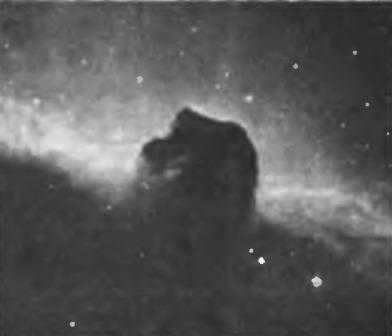
However, in spite of the existence of interstellar dust, there is a chance to observe celestial objects in the infrared spectrum. This is how the center of the Milky Way was captured on camera.
Visually. In other words, by closely observing it with the naked eye. Then, one can perceive that it’s not merely a hazy strip, but rather countless individual stars. Galileo was the first to make this discovery, even with his remarkably advanced telescope.
Because the birth of a star is like a “movie,” and human life is just one frame in comparison to the duration of this “movie.” The formation of a star takes hundreds of thousands and millions of years – and how much time do we dedicate to studying this process at a sufficiently high level?
Nevertheless: there exists a vast number of stars, and at any given moment a star is being born somewhere. Moreover, there are already numerous young stars and gas-dust nebulae where the processes of star formation are currently occurring. As an illustration of this article, here is an image captured by the VLT of an active star formation region within our own Galaxy. Alternatively, here is another instance of such a region located outside our galaxy.
Gravity does not possess power in the conventional sense. Instead, it is possible to estimate the gravitational potential or the acceleration experienced during free fall at a particular distance from the gravitational source (these are interconnected concepts: the gravitational potential is equal to -GM/r).
If we discuss the process of a star transforming into a black hole, then indeed, we must consider the initial mass of the star (as well as its final mass). In the case of a regular star, the pressure from its outer layers, essentially their weight, is balanced by the pressure generated during thermonuclear reactions occurring at the star’s core. When the star “burns out”, meaning when its thermonuclear fuel is depleted (which doesn’t necessarily have to be hydrogen, as there are other reactions occurring during late stages of stellar evolution), it collapses. For a star with sufficient mass, this event is observed as a supernova explosion. Therefore, when Mr. Toporov claims that “no one has observed” this phenomenon, he is mistaken. It has been observed numerous times. And, as one can ascertain, this phenomenon is not a disappearance at all, but rather the opposite.
The fate of a massive star, whether it collapses into a neutron star or a black hole, depends on its mass. According to theory, a star needs to have a mass greater than three times that of the Sun in order to end its life through collapse. However, this doesn’t necessarily mean it becomes a black hole; it simply becomes a compact object. This collapse is not an extinction event, but rather a bright flash during which a significant portion of the star’s mass is ejected into space and dispersed (we ourselves are composed of such matter). Therefore, the threshold of three solar masses is a purely theoretical value, applicable only under ideal conditions.
Speaking of which, the process of accretion will persist, hence causing the potential for multiple supernova explosions. During such an event, the central star undergoes a relatively minor loss in mass. However, it does result in some degree of cleansing in the surrounding space, indeed.
Nevertheless, that was just a poetic tangent. Let’s refocus on the main issue at hand.
Once again, the implosion of an enormous star into a black hole is the most luminous burst. And the conversion into a black hole is an inescapable conclusion for any colossal entities – provided that their mass surpasses the Oppenheimer-Volkov threshold. Nearly all neutron stars surpass this threshold, but the reality that they haven’t yet metamorphosed into a black hole is merely transitory. Neutron stars rotate, on an astronomical scale, at an astonishing velocity of hundreds of rotations per second. At that pace, the centrifugal force prevents them from experiencing ultimate gravitational collapse. However, as this velocity diminishes over time, the centrifugal force will eventually deplete, and coalesce. The neutron star will inevitably transmute into a black hole.
Meteors should be distinguished from meteorites and meteoroids. A meteor is not an object (i.e. a meteoroid) but a phenomenon, specifically a luminous trail left by a meteoroid. This phenomenon is known as a meteor, regardless of whether the meteoroid exits the atmosphere and returns to outer space, or if it burns up due to friction or falls to Earth as a meteorite.
A comet, derived from the Greek word κομήτης (komḗtēs) meaning “hairy” or “kosmaty,” is a small celestial body with a hazy appearance that orbits the Sun in elongated orbits. When a comet approaches the Sun, it develops a coma and sometimes a tail made of gas and dust.
An asteroid is a relatively small celestial body in the Solar System that orbits the Sun. Asteroids are much smaller and less massive than planets, and they have irregular shapes and no atmosphere, although some may have satellites.
1. What does the term “dwarf planet” mean? Can you name any dwarf planets?
A dwarf planet is a distinct category of celestial bodies. Some examples of dwarf planets include Pluto, Ceres, Charon, Vesta, Sedna, and many more.
2. Define small bodies in the context of celestial objects.
Small bodies refer to any objects that orbit the Sun and are not classified as dwarf planets or satellites.
Because their gravitational force is insufficient to retain a gas atmosphere, small bodies cannot hold onto one.
5. Is there a risk of Earth colliding with an asteroid?
There is a 1 in 20 million chance of Earth colliding with an asteroid larger than 1 km in diameter, and a 1 in 5 thousand chance of colliding with an asteroid measuring 100 meters in diameter.
A meteor is a luminous streak of light in the sky that occurs when a meteoroid interacts with the Earth’s atmosphere.
A meteorite is a fragment of a meteoroid that survives its passage through the Earth’s atmosphere and lands on the surface.
A bolide is an extremely bright meteor that is visible on Earth as a fireball streaking across the sky.
Every 33 years, we have the opportunity to witness a stunning meteor shower known as the Leonid meteor shower. This celestial event occurs when the Earth intersects with the densest part of a swarm of meteors that originates from the constellation of the lion. It’s fascinating to note that this connection between meteor swarms and comets has been thoroughly proven. In fact, it has been established that when a comet breaks apart, it creates a meteor swarm.
8. What is the radiant point of a meteor shower?
The radiant point is a specific area in the sky where the visible paths of individual meteors from the meteor shower diverge.
Occasionally, we may witness a bright meteor in the sky known as a bolide. Bolides are larger bodies weighing several grams or more. They can be brighter than the Moon or even the Sun, sometimes accompanied by a loud sound and leaving behind a bright and long trail.
If a bolide’s velocity is low and its mass is sufficiently large, there is a chance that it may not completely burn up in the atmosphere and its fragments will reach the Earth’s surface. These fragments of unburned matter are called meteorites. When a meteorite falls to the ground, it creates a crater-like depression, similar to the aftermath of a shell explosion, and at the center of this depression lies the meteorite itself.
What information can be deduced from meteorites? This fragment that has originated from outer space could potentially be a fragment of an asteroid, comet, planet, or another celestial object within our solar system. By analyzing the chemical composition of the discovered substance, we can gain insights into the nature of the meteorite.
Meteorites that are found can be categorized into three primary groups: stone, iron, and iron-stone meteorites.
Some stone meteorites may contain vibrant inclusions referred to as chondrules. These particles date back to the early stages of our Solar System’s formation, making them older than our planet itself. They serve as the only existing ancient material available for scientists to examine.
These particular meteorites make up a mere 2% of all meteorites that are discovered. They are believed to have formed at the boundary between the crust and mantle of their parent bodies.
These particular meteorites were once a part of either a planet or a large asteroid’s core. They possess the highest level of density on Earth and are strongly attracted to magnets. If you attempt to lift a cannonball, you will gain an understanding of the immense force involved.
Within this article, we shall examine the small objects that populate our solar system, exploring their origins and classifications. The field of astronomy will gradually transform from an esoteric science into an enthralling expedition throughout the solar system!
The night sky conceals numerous enigmas and secrets. Stars, planets, satellites, comets, and vivid streaks of meteorites – some of these celestial phenomena can be observed with the naked eye, while others necessitate the use of a telescope. Although the debate surrounding the inventor of the telescope persists, its significance in the study of space cannot be overstated.
During the 18th century, a pair of astronomers by the names of Titius and Bode formulated a principle that eventually became known as the Titius-Bode Rule. This rule suggests that the distances between the planets in the solar system grow exponentially, and according to it, there should be an unidentified planet located at a distance of 2.8 astronomical units from the Sun.
When Uranus was discovered at a distance of 19.2 astronomical units from the Sun, in accordance with the Titius-Bode rule, scientists received further validation for their hypothesis and actively began their search for the elusive planet.
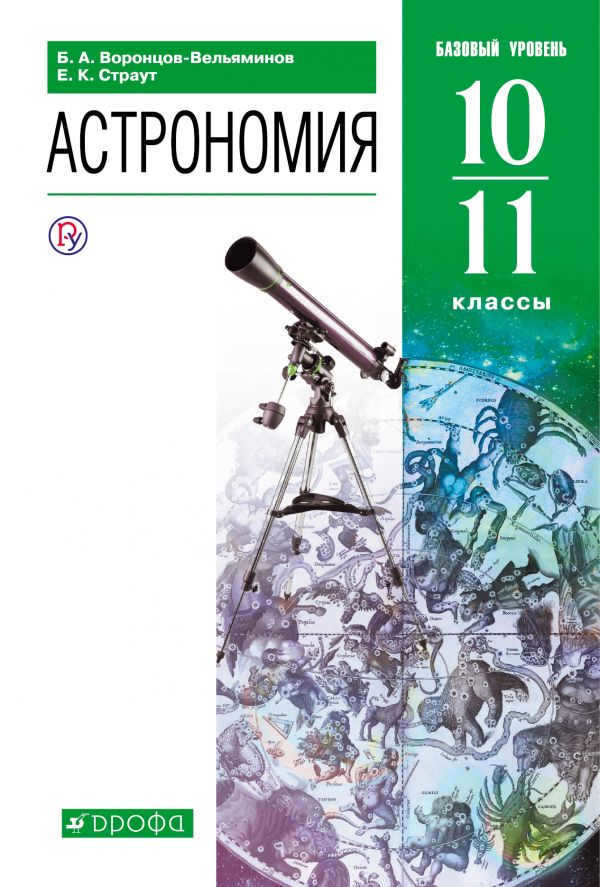
THE MYTH OF PHAETON
However, contrary to ancient myths and legends, contemporary researchers posit that the asteroid belt is not the remnants of a shattered planet, but rather a collection of protoplanetary material that was unable to coalesce into a fully formed planet due to the gravitational pull of the massive Jupiter.
ASTEROID: FACT OR FICTION?
An asteroid is a celestial object that resembles a small planet and orbits the Sun. Its diameter typically exceeds 10 meters.
Presently, the asteroid belt in our Solar System houses approximately 800,000 space objects. Out of these, 500,000 have had their orbits computed and assigned numerical designations, while around 21,000 possess unique names.
DWARF PLANETS
In 2006, a new category of objects in the solar system called dwarf planets was introduced by the General Assembly of the International Astronomical Union.
According to the definition, a dwarf planet must meet the following criteria:
- It must have a spherical shape, indicating hydrostatic equilibrium.
- It cannot clear other small bodies from its orbit.
- It is not a satellite of another celestial body.
- It orbits the Sun.
At present, there are five known dwarf planets recognized by astronomers. They are Pluto, Ceres, Makemake, Erida, and Haumea.
- The head of a comet consists of a nucleus and a coma.
- The tail of a comet is a plume of dust and gas that appears when the comet approaches the Sun and is visible due to the scattering of sunlight in the comet’s matter.
Comets are categorized as either short-periodic (with a circulation period of up to 200 years) or long-periodic (with a circulation period of more than 200 years).
The most extensively studied comet in the solar system is Halley’s Comet. Newton’s research enabled scientists to calculate the orbits of comets. Using his calculations, Edmond Halley determined the orbits of several previously observed comets, noticed their similarities, and proposed that they were all the same comet with an orbital period of approximately 76 years.
This celestial object was observed in 1531, 1607, and 1682. However, it was not until 1758, after the scientist’s passing, that the comet reappeared in the sky precisely as predicted by the researcher. This remarkable event led to the comet being named after Halley.
The most recent sighting of Halley’s Comet in 1986 left astronomers feeling disappointed, as the Sun obstructed the comet’s perihelion from the view of Earth. The perihelion is the point at which the comet is at its brightest and its tail reaches its greatest length. Astronomers are now eagerly anticipating 2061, when the comet is expected to make its most spectacular return.
METEORS. BOLIDES. METEORITES.
Those who have a desire to make a wish equip themselves with binoculars and gaze up at the night sky in hopes of spotting a shooting star. And the universe never disappoints: on clear nights, every now and then a bright streak appears across the starry sky.
Nowadays even a middle school student could explain that this magical occurrence is simply a meteoroid falling and burning in the atmosphere. However, in ancient times this extraordinary natural phenomenon left people in awe. Sometimes the sky is particularly abundant with shooting stars. And this indicates that the Earth is passing through a meteor stream.
What sets a meteor, bolide, meteorite, and meteoroid apart?
A meteoroid, or celestial body, refers to small pebbles, fragments of asteroids, and grains of sand that enter the Earth’s atmosphere.
A meteor is an occurrence in the sky at night or the path left by a small object passing through the Earth’s atmosphere.
A bolide is an especially bright meteor. It shines brighter than -4 m on the scale of stellar magnitudes.
One of the largest bolides that could be seen during the day was Benešov, which had a brightness equal to -21 m on the stellar magnitude scale. To comprehend the brightness of this event, it is important to note that the Moon has a brightness of -21 m, while the Sun has a brightness of -26 m.
A meteorite is a celestial body that does not completely burn up in the atmosphere and instead falls to Earth.
Sometimes, meteoroids do not completely burn up in the Earth’s atmosphere, but instead make their way to the surface, bringing with them rare space metal. Resourceful adventurers discovered how to manipulate meteoric iron during the period of the Bronze Age, well before the development of ore smelting techniques.
This extraterrestrial metal became the stuff of legends and was revered as a divine offering, with weapons crafted from it deemed sacred. Only leaders, pharaohs, and shamans were deemed worthy of wielding blades forged from this extraordinary iron.
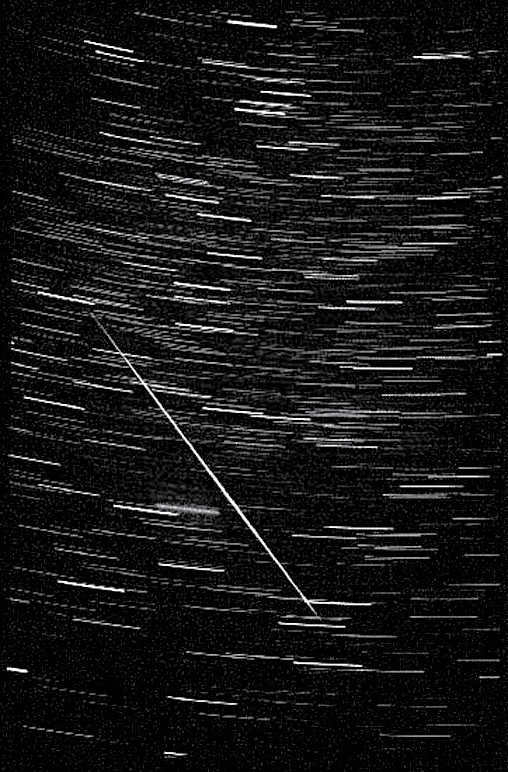
Figure 4.29 illustrates the trajectory of a meteor in the night sky.
By capturing images of the same meteor from locations that are 20-30 km apart, scientists can determine its parallactic displacement. This information allows them to calculate the altitude at which the meteor appeared and disappeared. Typically, meteors are observed at altitudes ranging from 130 to 80 km. If a camera with a rotating shutter, periodically blocking the lens, is used, the intermittent trail left by the meteor can be used to estimate its speed (see Fig. 4.29).
The comet’s nucleus releases solid particles that spread along its orbit, creating a massive meteoric matter torus (Fig. 4.30). These particles intersect with our planet’s path at specific points in its orbit. In the case of Halley’s Comet, the Earth encounters this torus twice a year – on May 4 and October 22. As a result, two meteor showers occur during these times – the May Aquarids and Orionids. Due to uneven distribution of meteoric matter in the orbit, the activity of certain meteor streams undergoes periodic fluctuations. For instance, the Leonids meteor stream produces plentiful meteor showers every 33 years.

Figure 4.30. The arrangement of asteroids
Youthful amateur astronomers are able to conduct successful and valuable observations of meteoric streams.
When a large celestial object enters the Earth’s atmosphere, it produces a phenomenon known as a bolide. Bolides resemble fireballs and leave behind a streak that can be visible for several seconds or, in rare instances, minutes. The most luminous bolides can even be observed during daylight hours.
In certain cases, the object responsible for the bolide does not completely vaporize in the atmosphere and instead falls to the Earth’s surface as a meteorite (see Figures 3 and 4 in color insert XIII).
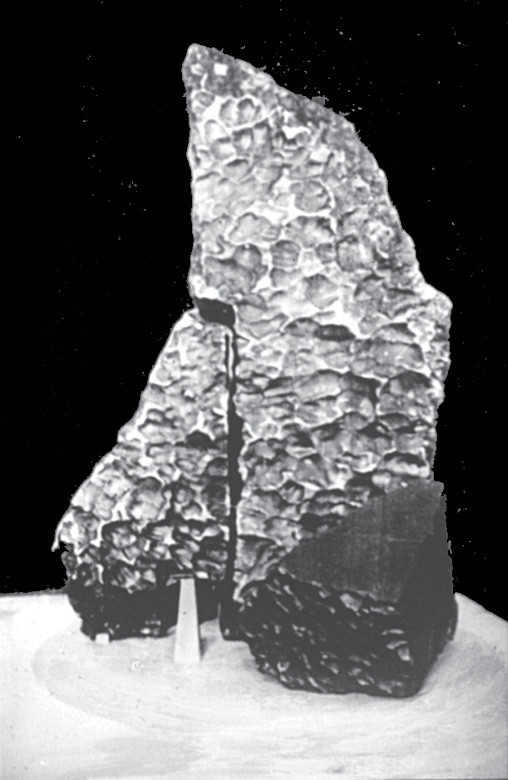
Fig. 4.31. An example of an iron meteorite
Meteorites can be classified into three types based on their chemical composition: stone, iron, and iron-stone meteorites. Iron meteorites consist mainly of nickel iron, with approximately 90% iron and 9% nickel. This unique composition sets them apart from terrestrial rocks (Fig. 4.31). When these meteorites are polished and exposed to acid etching, they exhibit a distinct pattern of longitudinal and transverse bands (Fig. 4.32). This pattern is formed during the slow cooling process of molten rocks within celestial bodies larger than 200-300 km in diameter. These characteristics, along with other evidence, suggest that meteorites are fragments from asteroids.
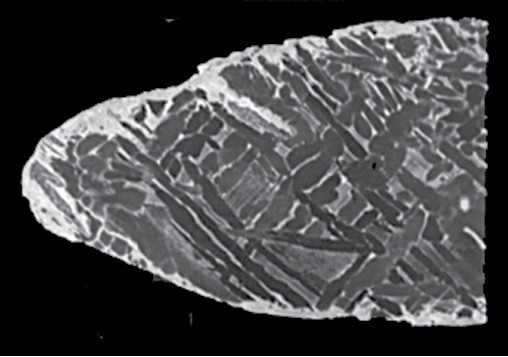
Figure 4.32 showcases the internal composition of an iron meteorite.
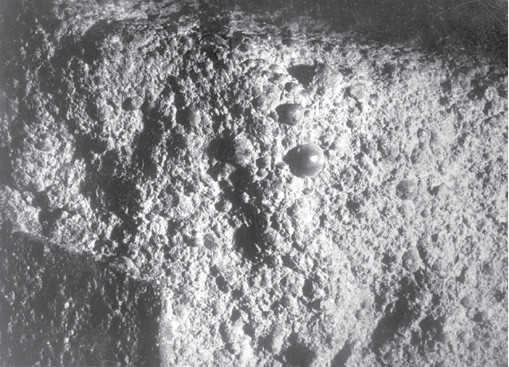
Figure 4.33 illustrates the arrangement of a stone meteorite containing chondrules.
The number of minerals discovered in meteorites is significantly lower compared to those found in terrestrial rocks. This provides valuable insights into the processes that occurred during the initial stages of solar system formation.
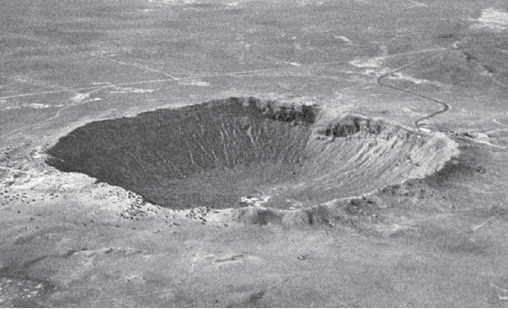
Figure 4.34. Meteorite crater in Arizona
Craters found on Earth-group planets, the Moon, and other planetary satellites are believed to be the result of meteorite impacts. Aerial photography has allowed for the discovery of approximately 130 such craters on Earth, which are now referred to as astroblems. One of the most well-known astroblems is the meteorite crater in Arizona, USA. This crater has a diameter exceeding 1200 m and reaches a depth of 200 m (Fig. 4.34). Scientists estimate that this crater was formed approximately 5000 years ago. Calculations indicate that the meteorite responsible for its creation would have had a mass exceeding 100 thousand tons.
One of the most notable meteorite falls in recorded history is the Sikhote-Alin meteorite, which had a weight of approximately 100 tons. This iron meteor shower descended on February 12, 1947 in the Ussuri taiga. Upon entering the Earth’s atmosphere, the meteorite shattered into numerous fragments due to its composition of iron-nickel crystals that were loosely connected. Some of the largest fragments, weighing several tons, impacted the Earth’s surface at great velocity, creating over a hundred craters. The largest of these craters measured around 26 meters in diameter and was approximately 6 meters deep.
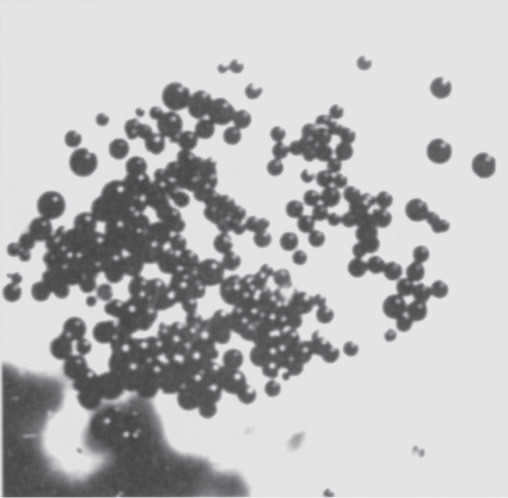
The shape of the majority of asteroids and their composition are quite diverse, as shown in Fig. 4.35. These celestial bodies come in various forms, including meteorite balls.
The flight of the fireball witnessed on June 30, 1908 in Siberia, known as the Tunguska meteorite, came to an abrupt end with a powerful explosion. The impact of this explosion caused the felling of nearly all the trees within a 40-kilometer radius. Despite extensive searches over the years, both the meteorite itself and the crater it would have created have eluded discovery. It is likely that a small comet’s nucleus entered Earth’s atmosphere, leading to its explosive destruction at an altitude of several kilometers. The resulting shockwave caused the collapse of the forest, but the energy released was insufficient to form a crater. The presence of solid spherical particles, measuring no more than 1 mm in diameter, found in the area, closely resemble those found at the sites of numerous large meteorites (Fig. 4.35). These particles are believed to be all that remains of the comet nucleus following its explosion.
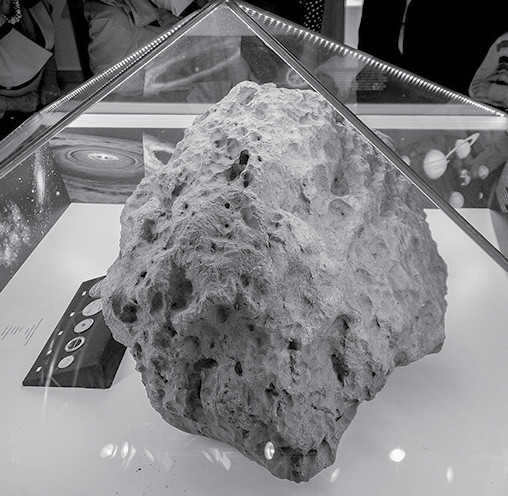
Scientists have determined that the Chelyabinsk meteorite had a size of approximately 19.8 meters and a mass ranging from 7,000 to 13,000 tons before it fell to Earth. However, only a small fraction of this mass, specifically 4 to 6 tons, actually made it to the surface, accounting for about 0.05% of the original mass. The largest fragment, depicted in Figure 4.36, weighed 654 kg and was retrieved from the depths of Lake Chebarkul. This particular fragment is now on display at the Chelyabinsk State Museum of Local Lore.

QUERIES 1. What are the distinguishing characteristics of an asteroid compared to a star during observations? 2. What is the predominant shape and approximate size range of asteroids? 3. What causes the formation of comet tails? 4. In what state is the substance of a comet’s nucleus and tail? 5. Can a comet that regularly returns to the Sun maintain its original composition? 6. What phenomena are observed when bodies travel through the atmosphere at cosmic velocities? 7. What types of meteorites are classified based on their chemical composition?

§ 21.THE SUN IS THE CLOSEST STAR

Figure 4.29 shows a meteor trace in the starry sky.
By capturing images of the same meteor from locations that are 20-30 km apart, it is feasible to determine its parallactic displacement and calculate the altitude at which it appeared and disappeared. Typically, this occurs at altitudes ranging from 130 to 80 km. If a camera equipped with a rotating shutter, which periodically blocks the lens, is utilized for photography, the meteor’s speed can be estimated from the resulting intermittent trail (Figure 4.29).
The comet’s nucleus releases solid particles that disperse along its entire orbit, forming a vast meteoric ring (Fig. 4.30). These particles intersect with our planet’s path at specific points along its orbit. For instance, the Earth encounters the orbit of Halley’s Comet twice a year – on May 4th and October 22nd. During these times, we witness two meteor showers – the May Aquarids and the Orionids. Due to the uneven distribution of meteoric matter in the orbit, the activity of certain meteor showers fluctuates periodically. For instance, the Leonids meteor stream produces abundant meteor showers every 33 years.

Fig. 4.30. The Majority of Asteroids in Different Forms
Young amateur astronomers have been able to successfully conduct valuable scientific observations on meteor streams.
When a large celestial body enters the Earth’s atmosphere, it creates a phenomenon known as a bolide. Bolides appear as fireballs and leave behind a visible trail that can be observed for a few seconds or, in rare cases, minutes. The brightest bolides can even be seen during daylight hours.
In certain instances, the celestial body responsible for the bolide does not completely vaporize in the atmosphere and instead falls to the Earth’s surface as a meteorite (see Figs. 3, 4 on color insert XIII).

Figure 4.31 showcases an iron meteorite.
Meteorites can be categorized into three types based on their chemical composition: stone, iron, and iron-stone meteorites. Iron meteorites are primarily composed of nickel iron, with 90% iron and 9% nickel. This specific ratio is not found in minerals found on Earth, making it relatively easy to distinguish iron meteorites from terrestrial rocks (see Fig. 4.31). When acid etching is applied to the polished surface of iron meteorites, a unique pattern of longitudinal and transverse bands becomes visible (see Fig. 4.32). This pattern is formed during the slow cooling process of molten rocks inside celestial bodies with a diameter of over 200-300 km. These findings, along with other data, support the theory that meteorites are fragments of asteroids.

Figure 4.32 illustrates the inner composition of an iron meteorite.

Figure 4.33 presents the arrangement of a stone meteorite containing chondrules.
A significantly lower amount of minerals has been discovered in the composition of meteorites compared to terrestrial rocks. This provides valuable insights into the events that occurred during the initial phases of solar system formation.

Figure 4.34. The Arizona meteorite crater
Meteoritic craters are found on Earth and other celestial bodies such as the Moon. A total of 130 such craters have been identified on Earth through aerial photography and are referred to as astroblems. One of the most well-known examples is the Arizona meteorite crater located in the United States. This crater measures over 1200 m in diameter and has a depth of 200 m (Fig. 4.34). It is estimated to have formed approximately 5000 years ago. Calculations suggest that the meteorite responsible for its formation would have weighed more than 100 thousand tons.
One of the most notable meteorites to have been witnessed falling is Sikhote-Alin, which had a mass of approximately 100 tons. This iron meteor shower descended upon the Ussuri taiga on February 12, 1947, breaking apart into countless fragments in the atmosphere. The meteorite was composed of iron-nickel crystals of varying sizes that were loosely bound together. The largest fragments, weighing several tons, impacted the Earth at incredible velocities, creating over a hundred craters and indentations. The largest of these craters measured approximately 26 meters in diameter and 6 meters in depth.

Figure 4.35 displays spherical meteorites.
The flight of the fireball observed on June 30, 1908 in Siberia, known as the Tunguska meteorite, came to a dramatic end with a powerful explosion. The impact was so intense that it caused the felling of almost all trees in a 40-kilometer radius. Despite extensive efforts over the years, no trace of the meteorite itself or its crater has been found. It is believed that a small comet nucleus entered the Earth’s atmosphere and detonated at a height of several kilometers, resulting in an explosive blast. This blast wave devastated the surrounding forest, but its force was insufficient to create a crater. The area did yield solid particles in the form of tiny spheres, measuring no more than 1 mm in diameter, which closely resemble those found at the sites of other large meteorites (Fig. 4.35). These spheres likely represent the remnants of the comet nucleus following its explosion.

Scientists have determined that the Chelyabinsk meteorite had a size of approximately 19.8 meters and a mass ranging from 7,000 to 13,000 tons before it fell to Earth. However, only a fraction of its original mass, specifically 4 to 6 tons, actually made it to the Earth’s surface. This represents a mere 0.05% of the total mass. The largest fragments, depicted in Figure 4.36, were recovered from the depths of Lake Chebarkul and had a combined mass of 654 kg. One of these fragments is now on display at the Chelyabinsk State Museum of Local Lore.

QUERY 1. How can we differentiate between an asteroid and a star when observing them? 2. What is the predominant shape of asteroids? What are their estimated sizes? 3. What causes the formation of comet tails? 4. In what state does the substance of a comet’s nucleus and its tail exist? 5. Is it possible for a comet that periodically returns to the Sun to remain unchanged? 6. What phenomena are observed when bodies travel at cosmic velocity through the atmosphere? 7. What types of meteorites are distinguished based on their chemical composition?






